 By Pepper Parr By Pepper Parr
November 9th, 2017
BURLINGTON, ON
What is the rush?
 The Draft of the Official Plan will be public on Friday – it runs close to 1000 pages. Those with a major interest in the contents of that document are going to have less than 20 days to respond to it. The Draft of the Official Plan will be public on Friday – it runs close to 1000 pages. Those with a major interest in the contents of that document are going to have less than 20 days to respond to it.
Suzanne Mammel, the Halton Hamilton Home Builders Association (HHHBA) Executive Officer explains that Official Plans usually go through at least half a dozen versions. The current document is in its second version.
Burlingtonians complain loudly and frequently about how city council fails to uphold there Official Plan.
There are four Mobility Hub studies taking place. The city wants to get the Downtown Core Mobility Hub approved before the end of the year.
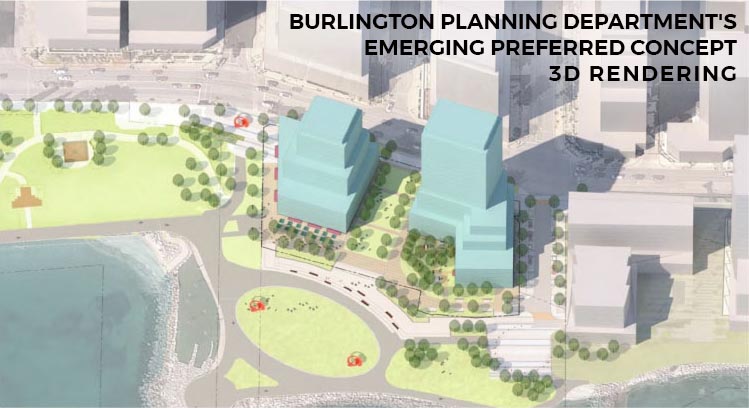 There are the plans for the redevelopment of the Waterfront Hotel property that the city is pushing with their Emerging Preferred Concept. There are citizens who don’t like what they are seeing. There are the plans for the redevelopment of the Waterfront Hotel property that the city is pushing with their Emerging Preferred Concept. There are citizens who don’t like what they are seeing.
What’s the rush?
The word is that James Ridge the city manager wants as much of this as possible approved by city council before they all move into major election mode.
There are citizens who want to suggest to the city manager that he lighten up and let these issues become election issues.
Related news stories:
The HHHBA has issues with the draft Official Plan.
What the HHHBA had to say with the first version of the Official Plan

 By Greg Woodruff By Greg Woodruff
November 3, 2017
BURLINGTON, ON
Lots of talk at last night’s council meeting on developing Brant street.
The thing that horrifies me is that people in support of the 23 story building or against it seem to have no idea why. Developer wants 27 stores, staff want 23 and the mayor wants 17. Average is 22.3 should we go with that? Here is how you should actually decide these things – with math.
 The typical Paris apartment building – six floors – “people love them”claims Woodruff. You never need to build buildings more than 6 floors high – ever. Skip the math if you like – down town Paris, France has a density of 210 per hectare and the buildings are limited to 6 floors – people love that place. The province requires 200 per hectare in down town Burlington. So in practice you can see an actual functional example of the density not needing to be high at all.
However for the skeptics lets go through the math and see why that is. I’m going to round these numbers for readability.
1 Hectare = 107,639 square feet
8% loss for roads/sidewalk 100,000 square feet (107,639/0.92)
50% lot coverage 50,000 square feet (100,000/2)
4/6 floors of living 200,000 square feet (50,000*4)
10% Hallway and amenity loss 180,000 square feet (200,000*0.9)
Density of 200 people or jobs per hectare 900 square feet living a person. (180,000/2)
I support large flexible large family apartments so my sizes are 1 bedroom 800 and 2 bedroom 1,200 and 3 bedroom 1,600. This is 6 floor buildings with a floor of commercial at ground floor and a floor of office space and left 50% of the ground open and provided very generous apartment sizes. I still have 5,000 square feet of feet space left over assuming all 1 bed room apartments with 1 person each which is not true in practice. This means lots and lots of space to add back to open space, road/sidewalks or reduce the building to 3 floors along the street which is preferred by pedestrians.
For reference the current density of Burlington is 10 people per hectare possibly 20 per hectare in the non-green belt area. Taking the already build on area to 200 per hectare would mean 2 million people would live here. Even if Copenhagen like ‘alternative’ transportation rates – which there is no evidence at all we could get anywhere close to and have done nothing to produce – road congestion and pollution alone will have reduced this area to a terrible slum long before we get anywhere close to that. The 183 cars proposed in this development alone would stretch out more that 1km in bumper to bumper traffic. That’s half the distance from the lake to Fairview street – from one development. Put that in your pipe and smoke it.
Which gets back to the decision. We can have high buildings – if the local community gets so much for the building – they want it. Seems the only people who want this building are the developers, city staff and councilors that do not represent Ward 2.
So would I approve it – no. It can be limited to 6 floors (yes I know the zoning is 12 at present) or the developers can come back with a better offer that gets people who live down town on board. The principle is: We live here – we decide.
Buildings larger than 6 floors are not required by any provincial planning document. Target density numbers of 200 people per hectare (down town) and 150 (mobility hub) do not require sky scrapers.
People who tell you large buildings are needed to hit density numbers are either mis-informed or spouting gibberish.
 Greg Woodruff Greg Woodruff is an Aldershot resident who has a propensity for numbers and mathematics. He ran as a candidate for Chair of the Region of Halton in the 2014 election. He appears to be setting himself up for a run in the Mayoralty race in 2018. His views are his own and are published as part of a civic debate.

 By Ray Rivers By Ray Rivers
November 2, 2017
BURLINGTON, ON
First we take Alberta then we take B.C. But not likely so in Ontario, even with all the animosity being heaped on current Premier Wynne from all sides. Still, who would have thought Alberta. And now B.C., where questions about the Site C and Kinder Morgan projects are making residents wonder whether their new leader, like the one next door, will be taking no prisoners.
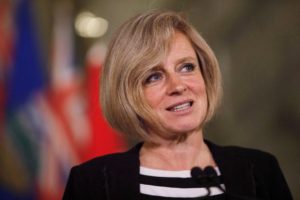 Rachel Notley, Premier of Alberta Not everyone welcomes the changes Rachel Notley is delivering in that free-spirited cowboy-centric land, though most concede that after four decades of the Progressive Conservatives (PC) it was time for a change. Peter Lougheed ended almost half a century of rule by those unconventional, depression-era, and once anti-Semitic Funny Money Social Credit people in 1971. He ran such a good show over his years that a review by a panel of powerful and prominent political hacks had voted Lougheed the best Canadian provincial premier ever.
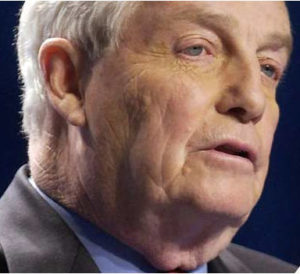 Peter Lougheed, one of the best Premier’s the province ever had. Lougheed eventually was followed by Ralph Klein, a man loved by his electors despite his own love for the bottle and an occasional outrage. He lasted over a decade despite being ranked near the bottom of the barrel in that review of premiers, tied with his ole’ drinking buddy Mike Harris. But Klein, a former Liberal, had come into office a reformed man, determined to out-right the right wing of the Alberta PC party. He was the darling of the Fraser Institute, which cheered him on as he eliminated deficits and debt, cutting spending like a novice butcher, inadvertently removing a lot of the beef with all that fat.
His cuts to health care were massive, such that the province was faced with never before seen waiting lists for surgeries, and with the gurneys lining up on the corridors. It was a legacy of neglect on almost all fronts which would come to haunt his successors and eventually the NDP’s Notley, as she struggles to diversify the provincial economy after the last oil price shock.
 Ralph Klein King Ralph was the first Canadian premier to introduce a flat income tax, which together with reduced corporate taxes and oil royalties forced him to raid Lougheed’s cherished Alberta Heritage Trust just to pay the bills. So today, unlike other oil money endowments established in Norway and Alaska, Alberta’s trust fund is almost empty. And when that proverbial rainy day came there was almost nothing left in the kitty to help keep the lights on.
Notley has done some pretty dumb things too, reportedly dispatching civil servants to teach Albertans how to change their light bulbs and conserve energy. But her success in cooperating with the federal government landed her approvals for the pipelines the province so-badly needs to keep its oil sands extractions busy. Setting a limit on climate change emissions from the oil industry, phasing-out coal fired electricity, and introducing a carbon tax more generous that what the feds had been demanding have made her a kind of maverick in a province too often known to be a donkey on the environment.
 Evacuation of Fort McMurray during fire storm But people will remember her for her passionate response to the wildfire that ravaged Fort McMurray, the oil sands capital. Eighty thousand people were forced to flee their homes as more than 6000 square kilometres were destroyed, including half a million hectares of woodland. Costs, always suspect in something of this magnitude range into the billions, with almost $4 billion just in insurance claims. Some will call this an act of nature, but others will say I told you so. They will point to the irony of the devastating fire happening smack on the footsteps of Alberta’s immensely carbon-intensive oil sands operations, saying this is but a prime example of being hoisted with our own petard – wait for the second shoe.
Notley has also pushed infrastructure development to create much needed jobs, in the process necessarily expanding the deficit beyond what her immediate predecessor, former Harper minister Jim Prentice, had been forced to reinstate. She’s been getting flack over her $15 minimum wage for 2018, not unlike the flack Ontario’s premier has been earning on that file. And her plan for farm workers’ accident compensation has got the agricultural folks all riled up, regardless that it is there to protect them from tedious and costly injury law suits.
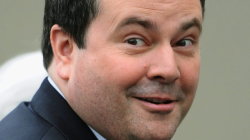 Jason Kenney Enter Jason Kenny and his recent accomplishment merging the PCs and Wild Rose parties under a new United Conservative banner. Kenny is much like Stephen Harper, another ex-Ontarian whom he worked for as Minister of Defence. His resume shows that, like his former boss, he is a professional politician who once headed a taxpayer lobby group. He is a social conservative, having voted in favour of limiting a woman’s right to choose and was one of those Harperites who voted against same-sex marriage – before he too saw the light. Those perspectives should do him well out on the prairie farmland, though he may need to moderate his views when he campaigns in the cities.
Although Notley had won a majority of seats in Alberta’s first past the post (FPP) system last election (54 of 79 seats) she only obtained a little over 40% of the total vote. That is still a respectable mandate for a multi-party FPP election, but it will be an uphill battle to repeat that victory. There was unusual voter anger in the last election – a sense of betrayal over an empty Heritage Fund, a tumbling economy, corruption and a stale government in disarray without any answers or vision once the price of oil went into the dumpster.
 The way Alberta’s cowboy culture likes to be seen. Memories in politics tend to be short and many of these voters have spent decades only voting PC. Like any addiction that can be a little hard to kick. So the NDP would do well to take the threat posed by new Conservative leader Kenny seriously. Winning the next election won’t be nearly as easy for Notley as the last time despite the fact that Alberta is coming back. In fact the province is on the road to restoring its position as one of Canada’s leading economic powerhouses – in part thanks to Notley’s management.
Background links:
Notley After 2 years – https://globalnews.ca/news/3427870/timeline-a-look-at-rachel-notleys-2-years-as-alberta-premier/
Lougheed the Best – https://www.edmontonjournal.com/technology/Alberta+Peter+Lougheed+easily+tops+list+Canada+best+premiers/6562534/story.html
Klein’sTrue Legacy – https://www.vueweekly.com/ralph_kleins_true_legacy/
Klein a More Positive Obit – https://beta.theglobeandmail.com/news/national/ralph-klein-70-the-man-who-ruled-alberta/article10569210/?ref=https://www.theglobeandmail.com&
More Klein – https://en.wikipedia.org/wiki/Ralph_Klein
Heritage Fund – https://beta.theglobeandmail.com/news/alberta/what-happened-to-albertas-cash-stash/article24191018/?ref=https://www.theglobeandmail.com&
Jason Kenny – https://en.wikipedia.org/wiki/Jason_Kenney
Notley Challenge – https://www.macleans.ca/news/canada/why-rachel-notley-will-need-an-even-bigger-miracle-to-win-again/
Kenny UCP – https://www.huffingtonpost.ca/2017/10/28/jason-kenney-wins-alberta-united-conservative-party-leadership-race_a_23259503/?utm_hp_ref=ca-homepage
Alberta Economy – https://www.cbc.ca/news/canada/calgary/alberta-conference-board-of-canada-spring-outlook-2017-1.4135837

 By Tony Brecknock By Tony Brecknock
October 30th, 2017
BURLINGTON, ON
Resident expresses an opinion that appears to be held by many – when 194 of 213 parents in a school sign a petition – the numbers have to tell you something. Might be something the ward trustee would make a note of.
In 2009 Lester B. Pearson high school didn’t appear to be targeted – or did it? The sudden rush to build Frank D. Hayden Secondary School, and the need to fill it too, without a doubt led to the sacrifice of Lester B Pearson high school. The following are the actual utilization (UTZ) numbers for 2008/9, along with projections.
In the 2009 Application numbers, Pearson was at 120.2% UTZ and fell to 90.3% UTZ in 18/19 – neither a radical change, nor a tip-off to later. Lester B Pearson enrollment went from 768 to 577. This is more than sustainable.
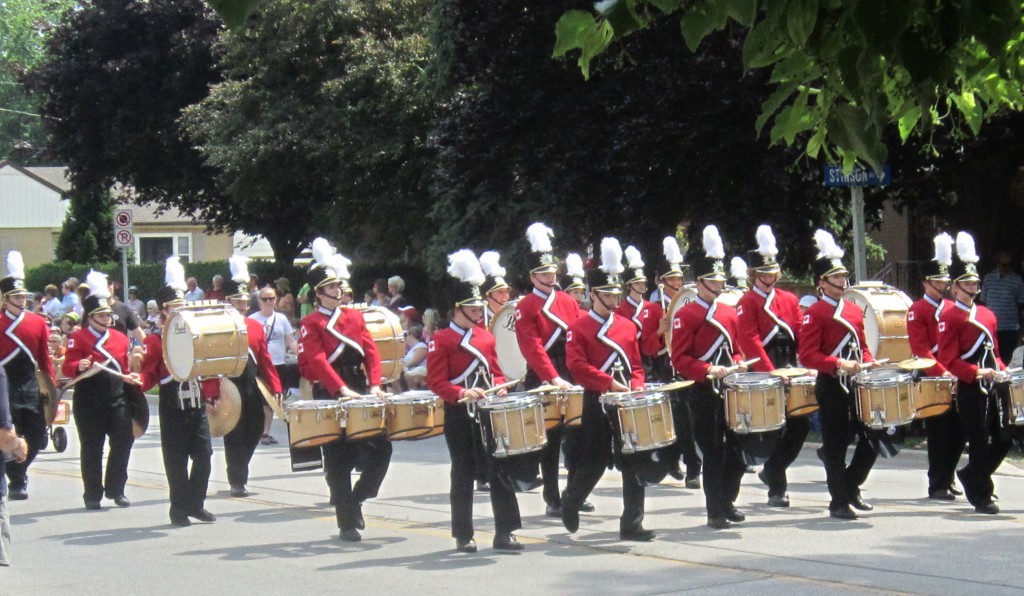 M.M. Robinson band – popular and energetic. Their school was spared serious consideration for closure when the data suggests they should have been looked at. It would appear that MM Robinson high school wasn’t even considered for closure, why? MM Robinson high school (MMR) was at 93.7% and fell to 53.4%. Enrollment went from 1262 to 719. Why was MMR spared?
All the others are as noted in the 2009 records, and Robert Bateman high school is given the lowest UTZ at 43.9%, projected in 18/19. and seems targeted, as it is bolded in red in the application numbers, but still has 588 students, down from 1327. Perhaps with its’ regional programs the Halton District School Board (HDSB) feels it is an easier target with moveable student sections. This would indicate that the HDSB did not look at the school population as a whole, but rather at the school/students as segments to be moved at will.
Note that in the 2009 Application numbers, the UTZ projections are more muted than in the PAR numbers, with Central, MMR, and Bateman all below Board targets of 65%.
Pearson is again at 90%, and Nelson is at almost 96%.
In the recent 2016/17 PAR data, things change to Pearson parent’s alarm. From the sudden removal of Kilbride students and their redirection to Hayden, to what was just the beginning of the intentional depletion of Pearson’s student body – what happened here between the application projections, and the PAR numbers?
What else except the building of Frank J. Hayden Secondary School and the HDSB planned draining of students to fill it? Choices were made on who got hit, and that changed the numbers. Why then, were school trustee Peggy Russell’s warnings ignored that Hayden’s build would create the exact situation we found ourselves in?
These planning choices were made by the HDSB in advance, and were not really on the agenda for the parents.
This raised the issue that these choices should have been on the table if the PAR for Frank J. Hayden secondary school was done when, and as it should have been, prior to the decision to proceed with the build of Hayden was made, sometime before 2008/09.
Absent the performance of this PAR, it appears to me, that no one wants to be held accountable for this decision, and for erroneous or short-term planning which causes long-term ramifications. So it is reasonable that parents and members of the community are arguing for the need for transparency and accountability for this.
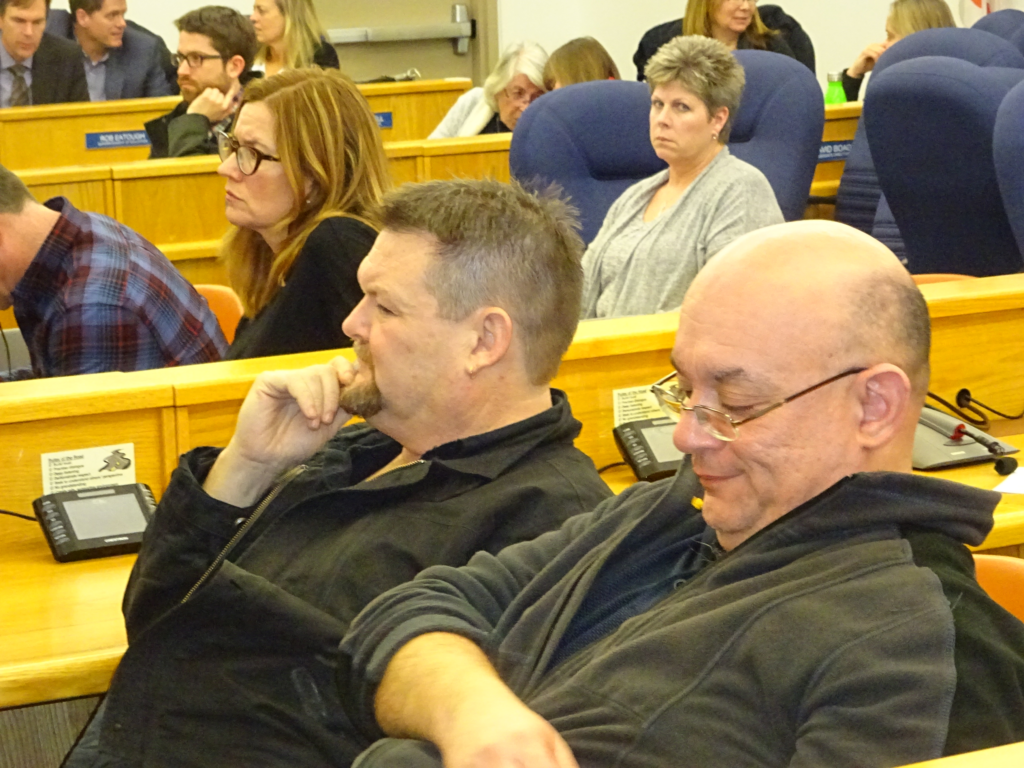 Parents from Central, Pearson and Bateman high schools were active observers in the PAR process. Parent engagement on these choices could have been enabled by not structuring the PAR process the way it was by the HDSB. This structure mostly consisted of various closing scenarios and this pitted parents against parents. Only one option was about no closures, but this was overshadowed by 19 plus options in total, mostly about closures.
At outside PAR meetings, consensus said it should have been done differently, to avoid the conflicts that were built in. It was felt that something like opening it up to the PARC and parents, describing the problem as a whole, and asking for options and possible solutions to solve the problem, would make sense and that kind of process would work for parents.
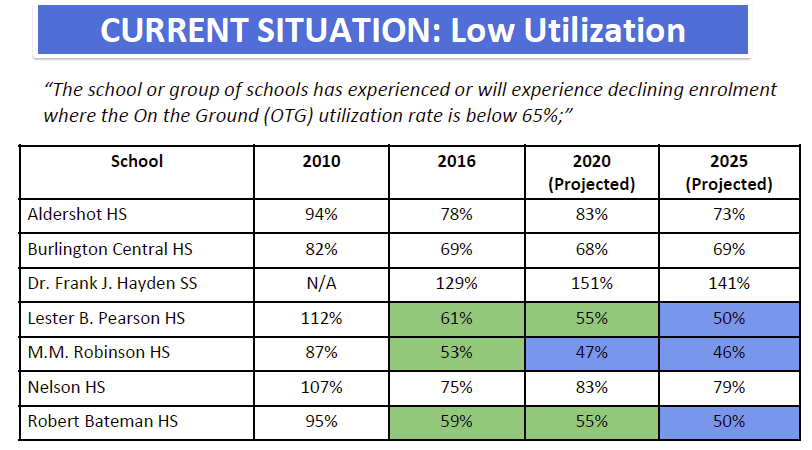 Instead, the HDSB predetermined ahead of time what the problem was – low utilization and surplus seats – but would never acknowledge that this was caused by them in their deliberate plans and concealing of the facts. In fact, the PARC members were presented with the problem of which school(s) to close as their starting point, not as one of their potential outcomes. Instead, the HDSB predetermined ahead of time what the problem was – low utilization and surplus seats – but would never acknowledge that this was caused by them in their deliberate plans and concealing of the facts. In fact, the PARC members were presented with the problem of which school(s) to close as their starting point, not as one of their potential outcomes.
 Hayden high school is part of a complex that includes a library and a recreation centre plus a dozen portable classrooms. Many believe that the opening of Hayden resulted in the need to close Pearson. So, the HDSB’s “solution” was to close schools in the south to eliminate the surplus seats and overcrowding they created by building a new school in the north without a Pupil Accommodation Review (PAR) to analyze and determine current and future needs in an open and transparent way. This did not work for parents, created crisis and conflict, and as such, the evidence of this presented by Lester B. Pearson and Robert Bateman high school parents was successful in convincing the Ontario Ministry of Education to conduct an Administrative Review.
This confirms that the appeal for an Administrative Review has merit, the PAR conducted late was inadequate, and the process followed did not accord with the PAR policies. This was a main effect of not having the PAR before the build of Hayden.
The HDSB made the decisions on allocating the enrollment before the PAR. In these PAR-based numbers, Lester B. Pearson high school goes from 112% UTZ in 2010 (actuals) to 61% in 2016, and to 50% in 2025. Big swing here from 90.3%. MM Robinson goes from 87% to 53% to 46% over the same time. Robert Bateman continues to fare the worst on UTZ – all the numbers are available.
 So, Robert Bateman high school was chosen as well, and it appears that having had Central high school as the focus early on in the PAR process, was simply in an effort to create a distraction from the real agenda. What were the UTZ numbers, and arguments, that changed the initial closure of Central to Bateman? So, Robert Bateman high school was chosen as well, and it appears that having had Central high school as the focus early on in the PAR process, was simply in an effort to create a distraction from the real agenda. What were the UTZ numbers, and arguments, that changed the initial closure of Central to Bateman?
I also wish to note, that somewhere between the 2008/09 application, and the PAR data presented in 2016/17 to justify two Burlington high school closures, Lester B. Pearson’s numbers were slashed in UTZ from 90.3% by 18/19 in the 2009 application, to 55% in 2020, then 50% by 2025 in the PAR numbers. Student numbers went from 577 to 319.
 In addition, there is no explanation – it was a subjective HDSB decision. As you know, with the changes made in boundaries, feeders and programs, Lester B. Pearson was chosen to close, with premeditation…..as was Robert Bateman. In addition, there is no explanation – it was a subjective HDSB decision. As you know, with the changes made in boundaries, feeders and programs, Lester B. Pearson was chosen to close, with premeditation…..as was Robert Bateman.
These policy changes were recognized as a key finding of our meeting as possible solutions that existed if partial reversals were undertaken. However, these changes were never seriously considered, as the HDSB was fixated on the empty seats and low utilization that they had themselves created. The HDSB never considered the actual board’s own data put forward by a community and the PARC members, looking at enrollment, and how the student experience and program offerings, depended on optimal allocation of enrollment, not maximizing utilization.
This fixation was apparent right to the final discussion and debate by Trustees at a Board meeting near the end. Options put forward, or questioned about, were dismissed by HDSB staff as not getting rid of all the surplus seats.
Incidentally, this dismissal was made by the same staff member that had supported, back in 2009, the building of these very same surplus seats through the build of Frank J. Hayden secondary school without a PAR analysis. It was suggested that since this enrollment focused option was factual, and based on the actual data from the Halton District School Board, it thus needed to be explored before a decision was made. But written delegations to support this analysis were ignored.
Remarkably, some Trustees had already written a school closing speech, and read it aloud, expressing their support of the decision to close our schools, prior to the final decision vote.
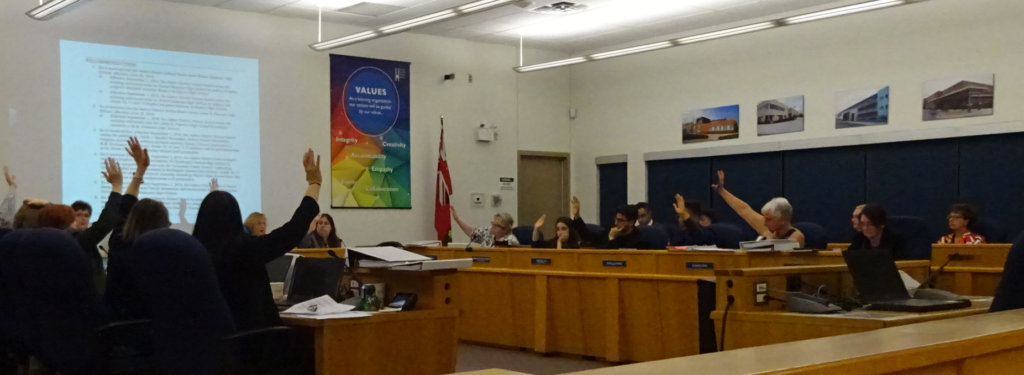 The night the school board voted to close two of its seven Burlington high schools the meeting went so late that the vote recording software had gone off line and the votes were done by the raising of hands. The final deciding vote was was made on the same night as more delegations were presented (against HDSB’s own 10 day procedural rule). Written delegation statements read that night had been prepared, submitted, and approved to present by Chairman Amos. So how much input did the final delegates even have?
This violation of HDSB policy, should without a doubt negate the final vote as they did not comply with their own rules.
The Pupil Accommodation Review Committee (PARC) really didn’t have much say in solving the real problem, as a member of the community put it, of optimally allocating the enrollment, and having that as a key discussion option on the PAR table. They did not get to communicate directly with the school trustees or vice-versa. All conversations or information was filtered through the board. Some PARC members certainly were hindered in sharing information with the community, all of which were PAR requirements.
It seems that the chief characteristic of this 2016/17 PAR is the planned sacrifice of two Burlington high schools, for a school planned and built without any PAR, in the north.
This was guaranteed to breed crisis and conflict, as it did.
So you see…..“There Is Merit To The Administrative Review”
 Tony Brecknock is a Burlington resident who is passionate about the school in his neighborhood that his School Board has decided to close. Mr Brecknock believes the Board is being less than candid with the people it is in place to serve and has set out his opinion on the Administrative Review that is now taking place. Tony Brecknock is a Burlington resident who is passionate about the school in his neighborhood that his School Board has decided to close. Mr Brecknock believes the Board is being less than candid with the people it is in place to serve and has set out his opinion on the Administrative Review that is now taking place.

 By Ray Rivers By Ray Rivers
October 27, 2017
BURLINGTON, ON
If Kathleen Wynne’s Liberals are not re-elected come the provincial election next year, it will partly be because of how the Liberals have managed and mismanaged the energy file. True enough there has never been a power blackout or even a brownout over their period of governance – as there had been regularly during the previous Harris/Eves government. But the price of electricity had been dramatically rising, at least until this past summer when it tumbled by a whopping 25%.
There are a number of reasons that account for why our hydro bills had been rising:
1. Neglected maintenance – During the Rae and Harris years electricity infrastructure, transmission in particular, had been sacrificed resulting in brown and black outs;
2. Privatization – New generation, whether renewable or conventional energy required long term contracts with fixed prices and guaranteed purchases;
3. Labour Costs – The utilities’ employees are among the best paid in the province, senior executives with Ontario Power Generator (OPG) and Hydro One in particular; and
4. Waste – Most memorable is the billion or so spent to cancel new gas plants still under construction, allegedly to save electoral seats in the GTA.
 Maintaining the system has not always been the top priority – we end up paying for it eventually. For a generation Ontario Hydro had typically debt-financed its operations, even before the Davis government. In fact when Mike Harris dissolved Ontario Hydro at the turn of the millennium he discovered an accumulated debt load of almost $40 billion, some $20 billion greater than the value of all of the utilities’ then current assets.
This stranded debt had been placed on our utility bills until more recently when the Liberal government eliminated it.
As rates started rising over the McGuinty/Wynne years, lower income families complained about how they couldn’t afford to pay their hydro bills, some businesses threatened to move out of the province, and even the left wing media were doing an almost daily grind on electricity prices. So early this spring the Premier responded to the criticism by taking out a mortgage, the way someone looking to renovate their house might do. She is using the borrowed money to cut electricity bills for small business and residential customers by 25%.
In a way it’s just turning the clock back. And it’s fair game for opposition politicians to call this a political pre-election move. It sure looks that way – trying to win votes by lowering hydro bills today and paying the piper tomorrow. It’s OK for the political parties to do that – call her out – but not Ontario’s Auditor General, Bonnie Lysyk who is supposed to be an independent officer of the legislative assembly. Instead she is acting like the king-maker James Comey did in the last US election.
The nub of her report is that it would have been less costly to finance the 25% rate cut by adding to the provincial debt rather than piling it onto OPG and its financing agency, because Ontario’s credit rating is better than OPG’s and the interest rate is lower. She is right to point that out but not to assign motive on behalf of the government – that is my job and the job of the opposition parties. And the government would likely respond that the debt should go to the rate payers rather than the general public – something she fails to note.
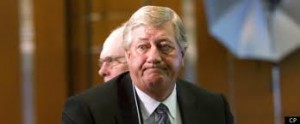 Former Premier Mike Harris was no friend of a “Best in the Business” hydro system. The Ontario AG delivered another scathing report almost two years ago in which she decried the use of long-term fixed-price electricity supply contracts, but failed to offer any alternative as to how the system would work otherwise. It has been the provincial policy since the time of Mike Harris to bring on new energy sources through the private sector using long term supply contracts. And the private sector needs the security of a contract to ensure that it receives a fair return on its investments.
Again, she was right in pointing out that privatization had been a costly exercise. But somebody on her staff needed to take a course in micro-economics 101. She presented an imaginary $37 billion number, a purely hypothetical figure which might as well have been pulled from the air. But it is a complicated file, her strength is accounting not economics, and so her report then, as now, was only partly helpful.
Over the last decade Ontario’s energy costs climbed to be the highest in Canada – though still much lower than those in the major North American centres in California and New York. With the 25% reduction Ontario has fallen more in line with the other provinces. But of course it will never be able to compete with Quebec, Manitoba or BC. These jurisdictions have a tremendous advantage with their low cost water power endowment, and they have also retained their provincial monopolies to generate and distribute electricity reliably and cheaply.
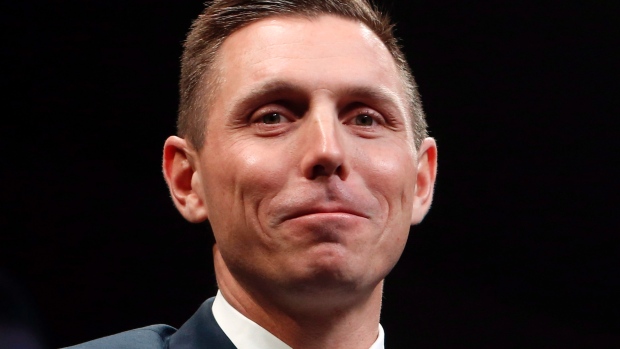 Leader of the Opposition at Queen’s Ark – Patrick Brown New Progressive Conservative leader Patrick Brown claims he’d tear up the province’s long term supply contracts, much as Dalton McGuinty promised to tear up the 407 lease Harris had signed years before him. It was simply not possible, the lawyers had sealed it well. And even if Brown were legally able to do that, how would he replace these contracts – how would he keep the electrons flowing and the lights on? I am one of the hundreds of Ontario residents who operate a small solar energy project under Ontario’s MicroFIT energy program. Without a reasonable assurance of market access and price no reasonable business entity is going to take a gamble investing in a public sector electricity system.
Brown is not someone to be underestimated. Over the relatively short period of time he has been provincial Tory leader, the former Harper disciple and MP, has moderated and adapted. In fact he has boldly reversed his view and position on abortion, same sex marriage and sex education in schools. And it has worked for him, he is now leading in provincial popularity with almost half those polled saying they would vote for him. He has been a strong and vocal critic of the Liberal government at Queens Park and on the electricity file in particular.
But if he is to become our next Premier he has to do more than just criticize – to tell us what he wouldn’t do. Brown, who had been promising to release his party’s long term energy plan several months ago, almost immediately pulled back from that promise until next year and the election. Indeed it would be very helpful for Mr. Brown to present a coherent alternative. After all it was his party who created this chaos in the first place by dissolving our relatively stable and low cost provincial electricity monopoly. He might want to look to Quebec, Manitoba or B.C. for inspiration.
 Ray Rivers writes weekly on both federal and provincial politics, applying his more than 25 years as a federal bureaucrat to his thinking. Rivers was a candidate for provincial office in Burlington in 1995. He was the founder of the Burlington citizen committee on sustainability at a time when climate warming was a hotly debated subject. Tweet @rayzrivers Ray Rivers writes weekly on both federal and provincial politics, applying his more than 25 years as a federal bureaucrat to his thinking. Rivers was a candidate for provincial office in Burlington in 1995. He was the founder of the Burlington citizen committee on sustainability at a time when climate warming was a hotly debated subject. Tweet @rayzrivers
Background links:
Ontario 2003 Black-out – Bruce Nuclear Deal – Stranded Debt – Auditor General Report –
More AG – Large Renewable Suspended – MicroFit Valuation – Patrick Brown Energy Plan –
Ontario Polling –

 By Ray Rivers By Ray Rivers
October 23rd, 2017
BURLINGTON, ON
Except for the provincial Liberal government nobody seems to like Quebec’s new law Bill 62, banning face coverings for those seeking or providing public services. The rest of the country is either muted, reserved or pointedly critical. Most people think the law is racist since it will largely target one group of Quebec residents – Muslim women who wear some kind of veil to cover their faces. And that certainly fits at least one of the definitions of racism.
 Is it a fashion statement or a religious statement? Is a deeper understanding what will remove the fear? The burka, or more generally the niqab, is not properly a part of Islam and not even mentioned in the Quran. It is a cultural artifact at best. And not all Muslims wear the face veil, even among those within the same Islamic religious order. It is ironic, though, that while women in Quebec are being legislated to leave their face veils at home, females in Iran are beaten and imprisoned for doing exactly that.
The two opposition parties in Quebec’s legislative assembly think the law hasn’t gone far enough. They’d ban all religious paraphernalia, like crosses, the Jewish yarmulke , and even turbans, including one like the newly elected leader of the NDP, Mr. Singh wears. Of course that would make campaigning a bit of a problem for him in the very province where the NDP did so well only a few years ago. Though if all religions are equally affected by the law, one could argue it is less racist.
 In God We Trust is printed on all American currency. The Americans have it in their constitution so Canadians think we do as well – the separation of church and state. But if so, why then is ‘In God We Trust” on their money and why do we have God in our national anthem? Indeed religion has always played a role in our political history, even before the Europeans migrated here. But how far should the state venture in managing how people carry out their faith?
There is an argument that someone applying for a drivers license or passport needs to show her face – to ensure she is who she says she is. Mr. Harper felt that principle extended to citizenship services, to be sure the new Canadian is actually saying her oath to the country. And one can only wonder at how effective a veiled woman might be trying to teach a class of young children. But to deny someone wearing a mask to board a bus, seems to be going too far, unless that someone is planning a token robbery.
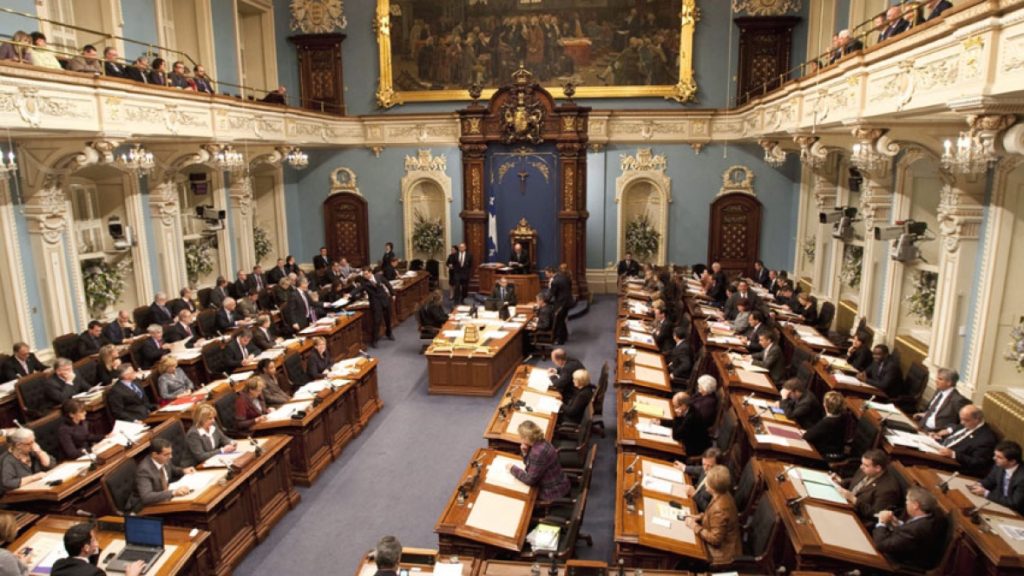 Was the niqab decision made by the government of Quebec a reflection of social values or was it a crass political move to shore up support for the provincial government? Still, Canada is not officially a religious nation despite the vestiges of the past, like that big cross which hangs in Quebec’s national assembly. Social researchers were speculating barely thirty years ago that houses of worship might one day be relegated to the history books. But that obviously was an inaccurate prognosis. Religion is actually making a come back thanks to immigration.
Back in the day, Pierre Trudeau believed that the best way to deflate Quebec nationalism, and the demand for sovereignty, was to encourage multiculturalism though immigration. But most Quebecers were never big on that policy as one can imagine. Having emerged from literally centuries of being controlled by that other religion, Catholicism, they had been enjoying their liberation until the niqab seemed to threaten the preservation of their own just society – one based on gender equality, aesthetics notwithstanding.
 A group of women in their religious clothing.  Nuns in the province of Quebec in their religious clothing. There will certainly be a challenge through the courts including the Supreme Court, and if the Liberals are still in power in that province by the time this law is declared to violate human rights, Premier Couillard may have to use the notwithstanding clause – or he may fix it in some way. But this issue is not going away and it is unhelpful for other provinces like Alberta and Ontario to chip in from the sidelines, fomenting potential inter-provincial animosity.
It is worth noting that since 2011 France has executed an even more extensive law, banning the wearing of face coverings in all public places, including streets and parks. The new law, Bill 62, may be racist, but Quebecers are not – they are just trying to conserve their own culture from something they don’t fully understand. Despite our PM’s more recent comments on this file, he’d be well advised to leave it alone. This is a matter that needs to be resolved in Quebec by all Quebecers, including those impacted by the law.
 Ray Rivers writes weekly on both federal and provincial politics, applying his more than 25 years as a federal bureaucrat to his thinking. Rivers was a candidate for provincial office in Burlington in 1995. He was the founder of the Burlington citizen committee on sustainability at a time when climate warming was a hotly debated subject. Tweet @rayzrivers Ray Rivers writes weekly on both federal and provincial politics, applying his more than 25 years as a federal bureaucrat to his thinking. Rivers was a candidate for provincial office in Burlington in 1995. He was the founder of the Burlington citizen committee on sustainability at a time when climate warming was a hotly debated subject. Tweet @rayzrivers
Background links:
Burka Bill – Religious Neutrality – Separation of Church and State –
What Canadians Believe – Feds on Religion Law – Ontario Reaction –
Burka in Quran – Who wears a Niqab –

 By Tom Muir By Tom Muir
October 21st, 2017
BURLINGTON, ON
The timing of that PAR in relation to the timing of the Hayden build was perfectly orchestrated by the Halton District School Board (HDSB). The lack of a PAR for Hayden was denied as a point for discussion and the HDSB Board and Director of Education Mr. S. Miller worked extensively to keep it hidden.
Was there any transparency when it came to the Hayden build? Well, members of the community had to go to the Freedom Of Information in order to get any information at all to learn more about how Hayden was planned, approved with known consequences, and built regardless. It appeared that this consequential matter was buried by the Board at the very first Pupil Accommodation Review Committee (PARC) meeting. The parents never had a chance. Just having to go Freedom of Information (FOI) says a great deal about the motives involved.
 Hayden high school – sen as the nicest high school in the city – Muir thinks it was foisted on the public ti justify closing two high schools south of the QEW This decision by the Board to hide the facts of this was an ethical and moral failure. The PAR was started with dishonesty about how they planned and got us to that position, in the direct, known consequences of the Hayden build, and then it was hidden and covered-up throughout. The partnership with the city for more facilities is not a credible excuse, as this was something that happened after the fact of the build plan getting approved. The conception of the build, and the plan, had nothing to do with the partnership, which only came because the build was basically underway.
Reading through the Boundary Review of 2012, it is obvious again that Hayden could go to 1800 students, and that a PAR was justified then, on these grounds alone. Added to this, it was evident that most of the other schools were sure to be driven to much lower numbers. No warning was given to parents of these consequences.
While Lester B Pearson HS remained at 83% UTZ (utilization), there was no warning that this would change as the boundaries and feeder schools were chosen to feed and justify Hayden. MMR was projected at 48%UTZ, but was then favored with more students. A Bateman parent expressed her concern that her child’s special program would be moved, but was assured by the HDSB that programs would not be moved. These are just some of the reasons why parents are objecting to what was done.
Among other things, the FOUR top criteria of the Boundary Review (BR) were:
1. Balance of overall enrolment in each school in the review area to maximize student access to programs, resources, and extra-curricular opportunities.
There were no efforts to achieve this one, including in the PAR. With Hayden projected to an 1800 student enrollment in a 1200 student OTG, how can this criterion be claimed to be acted on and key?
This criterion was analyzed by many members of the community, revealing that balanced, optimal enrollment among schools would provide the best and maximal access to programs etc. – better than maximizing utilization, which is what was factually implemented. Again, how does this fit?
2. Proximity to schools (walking distances, safe school routes, natural boundaries)
Hayden has the second highest busing costs and moves 580 students, almost half of the On the Ground (OTG) capacity, and 1/3 of the high projected enrollment of 1800. On page 4, last line, in the Boundary Review report, it states that The majority of students attending the new Burlington NE high school will be able to walk to school. So how does this fit, as the busing data says it’s not so?
3. Accommodation of students in permanent school facilities and minimal use of portable classrooms
As noted again, there are 12 portables at Hayden and 6 more are stated as needed in future. These will house up to 600 overfill students. So how does this fit this key criterion?
4. Stable, long-term boundaries
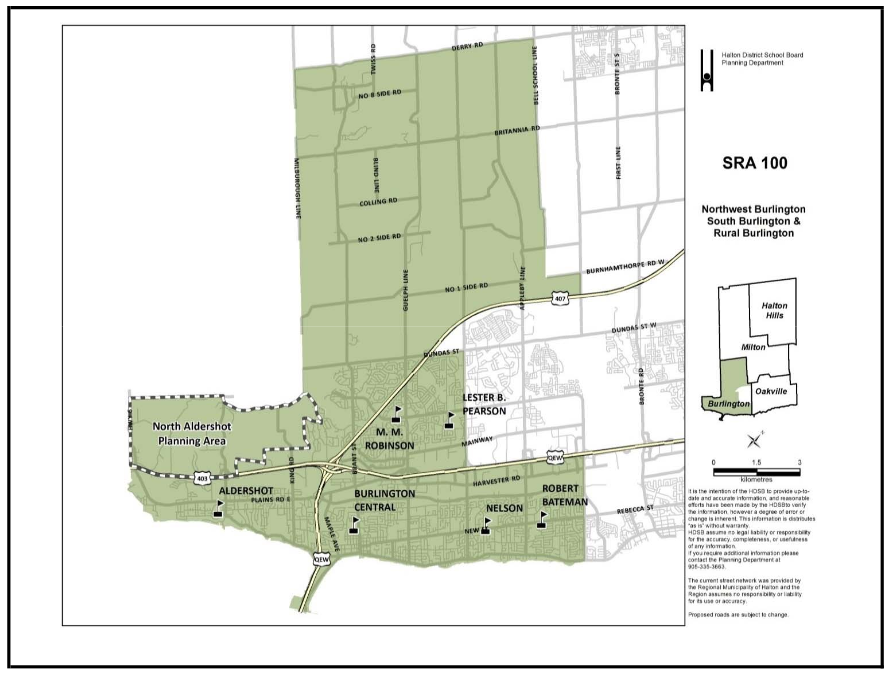 Certainly, it looks like no matter how overfilled Hayden was projected to become, and in fact did so, with portables, busing and 151% UTZ, the boundaries chosen, and feeders, that generated this result remained unchanged. This outcome, despite several other schools becoming under-filled and under-utilized, seems to reveal again the Board premeditated plan to close schools – the boundaries chosen by the board were kept stable, regardless of the cost of 2 schools. Certainly, it looks like no matter how overfilled Hayden was projected to become, and in fact did so, with portables, busing and 151% UTZ, the boundaries chosen, and feeders, that generated this result remained unchanged. This outcome, despite several other schools becoming under-filled and under-utilized, seems to reveal again the Board premeditated plan to close schools – the boundaries chosen by the board were kept stable, regardless of the cost of 2 schools.
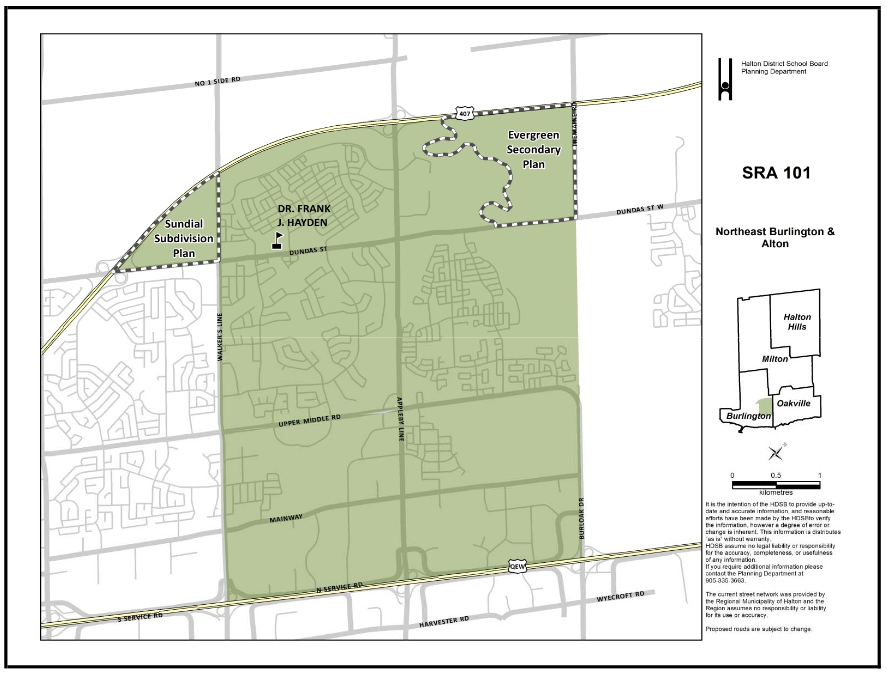 So they delivered on this criterion, even in the PAR. Again, how does this fit what the parents I think would consider a trustworthy and rational decision to contribute to the benefit and well-being of the students, and the community of schools? So they delivered on this criterion, even in the PAR. Again, how does this fit what the parents I think would consider a trustworthy and rational decision to contribute to the benefit and well-being of the students, and the community of schools?
Overall, the issue is not so much building Hayden, but that it was done without a PAR to provide information and analysis of the consequences for all the schools in the review area covered by a Boundary Review (BR). This BR was clearly inadequate and people were in effect deceived by a lack of dire warning of what was to be.
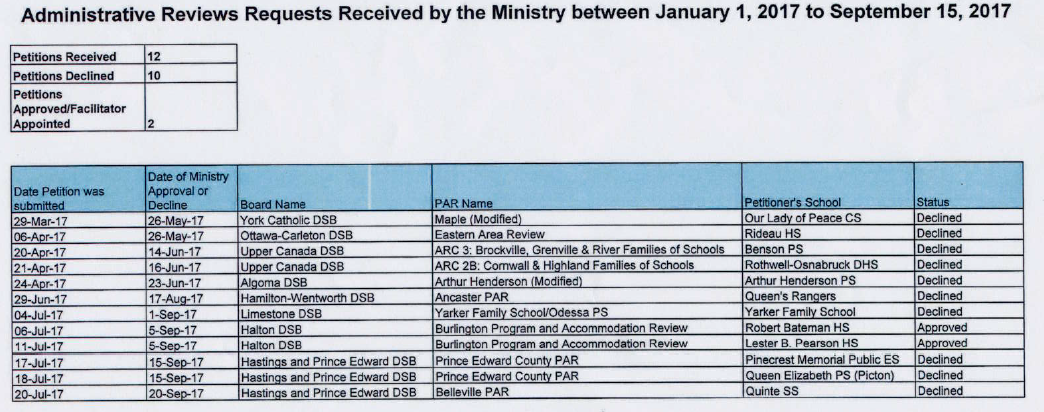 The Halton Administrative Review requests were the only ones to be approved by the Ministry of Education The “timing” of that PAR in relation to the “timing” of the Hayden build, and the resultant planned and deliberate building of seats that became surplus in south Burlington, is what inevitably led to the decision to close two schools. It should also be noted, that the two Burlington requests for Administrative Reviews are the only ones that have been approved out of the 12 applications from across the province so far this year.
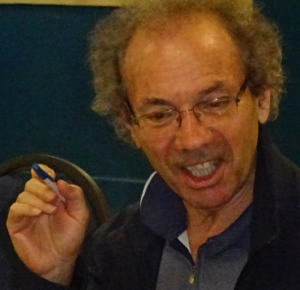 Tom Muir Tom Muir, a retired federal civil servant has been a consistent observer and critic of civic government. He resides in Aldershot where he is an astute commentator on development in that community. His views are his own.

 By Rory Nisan By Rory Nisan
October 19th, 2017
BURLINGTON, ON
When I grew up here in the 90s, North Burlington was a suburb of a suburb. It was not at the centre of Burlington, itself a suburb of the behemoth known as Toronto. The streets were quiet at night, schools were safe, neither over- nor under-filled. Many readers will know that Burlington enjoys a high ranking on various lists of places to live and it was equally considered a top destination when my family moved to Brant Hills in 1989.
Yet, Burlington has changed. For example, it has grown. More people and more traffic. And big change is ahead for our town.
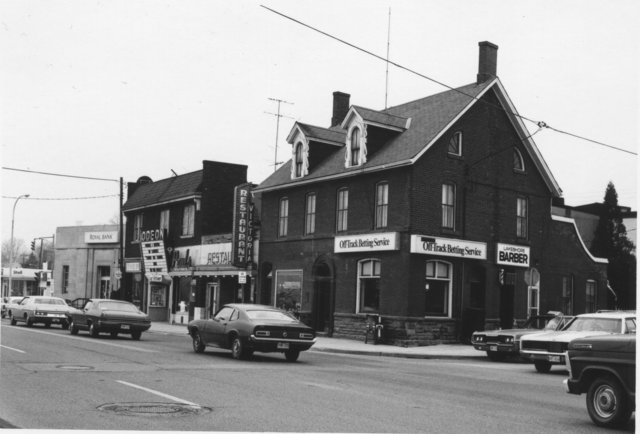 Burlington has indeed changed – the old Odeon Theatre entrance and the old Royal Bank building are shown. One of the biggest changes for North Burlington in many years may be upon us, as my alma mater, Lester B. Pearson High School, is on the verge of closure (though not if we can stop it), leading to MM Robinson and Hayden becoming XXL schools with kids spending much of their careers in portables and struggling as numbers in a big system.
A lesson that many of us who have worked to save Robert Bateman and Lester B. Pearson high schools have drawn is that we must send our best and brightest to public office, and then hold them to account between elections as well as at the ballot box. We were lulled into apathy and thus caught with our guard down when Pearson was first recommended for closure one year ago.
That unnecessary recommendation was followed up by a process of ‘consultation’ that led to little more than a rubber stamp by the Halton District School Board (HDSB) trustees, who voted on June 7, 2017 to close both Robert Bateman and Lester B. Pearson high schools. Now we as a community are dealing with the fallout caused by HDSB trustees, including several in Burlington, who were not up to the task.
Meanwhile, the city’s other elected body is overseeing major changes in the name of “mobility hubs” and “provincial growth targets” that mean that the next months and years are going to be critical to developing the character of Burlington for decades to come.
As a Gen-Y’er, I can’t help but notice the city is looking many years ahead, and including mobility hubs and the condos and young professionals that go with them in their plans, yet our voice is nowhere to be found on city council.
 Haber Recreation centre – best in the city is in North Burlington. Meanwhile, North Burlington is sometimes left out of the discussion of Burlington’s future. The city would usefully innovate and invest in building community and infrastructure in North Burlington to bring equality of outcome for North Burlington residents compared to those in the core. The south has Spencer Smith Park and all of its events; it has city hall and the lake as natural draws to bring people together.
North Burlington residents paid equally for the pier, the Burlington Performing Arts Centre and the Art Gallery.
With all of our tax dollars that have been invested in the downtown, we deserve more support for community activity in the North and the kinds of innovation, investments and energy that is brought to the downtown community.
The North has received some investment, yet we are seeing that investment being hampered in some cases. For example, the Haber Recreation Center, public library and Dr. Frank J Hayden High School complex is impressive, but its success is undermined by the conversion of much needed parking spaces into 12 unplanned and effectively permanent school portables. Furthermore the public library is being over-run by students because there isn’t enough space for them in the high school.
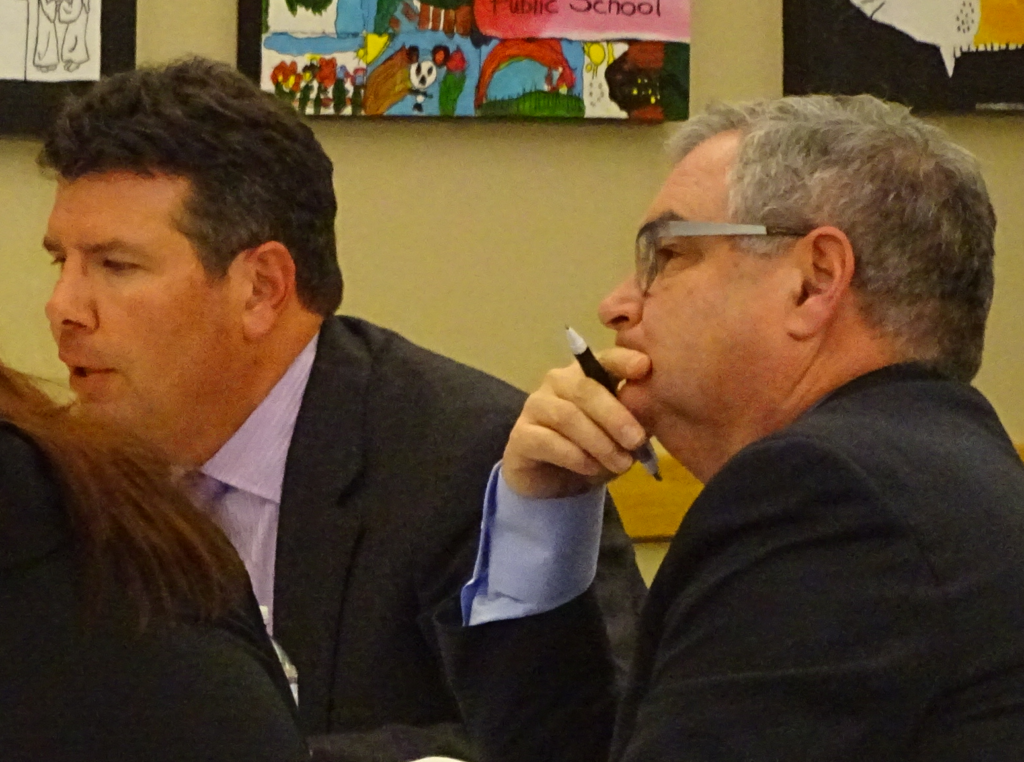 City Manager James Ridge, on the right, was the city council voice at the PAR committee meetings – he didn’t have much to say. Our City Council has been nearly silent on the fallout from the HDSB’s mismanagement of pupil spaces in North Burlington, and especially on the foolhardy and nearsighted decision to close Lester B. Pearson high school, which will only make students’ lives worse. We need to hear from them on this decision that affects so many of us.
Finally, we do get out and enjoy the downtown when we can make the trip. And we want to see it continue to be a destination for everyone in Burlington and the surrounding area. Like almost everyone else, we do not want to see the lakeshore and downtown dominated by skyscrapers. With the Ontario Municipal Board being replaced by the Local Planning Appeal Tribunal soon in order to empower cities, now is the time to say “no, thank you” to 22-story buildings on the lake, and demand only the best in terms of high-rises.
 Development is taking place – the three structure project on Lakeshore Road will limit the public view of the lake – the read line in the middle of this photograph is the width of the opening to the water. Development is inevitable and can be part of making a city better, but only if the development is carefully managed to not undermine what makes the city great. There is no reason we cannot hit our development targets without the highest of high rises in the downtown core, and that should be the goal. While we’re at it, we need to stop any high rises blocking views of the escarpment as well, or otherwise changing the character of neighbourhoods.
Finally, while City Council is telling us that the city is going to grow upwards rather than outwards, it is underinvesting in public transit to the point where safety is a concern.
At a city council meeting in September, one member made it clear that ‘throwing money at the problem’ wasn’t a sufficient answer. He may be right, but that member could be usefully reminded that it is their responsibility to lead the city towards innovating and investing to bring Burlington’s public transit up to par. For Burlington to be a modern city in 2017, these investments need to be made before the growth occurs, not after.
To make Burlington truly better, innovation and smart investments are key. With a strong tax base, we have every reason to expect this from City Council. They approved a tax increase above and beyond the recommendation of the city in 2017, so it is now up to them to show us they are making our tax dollars work to bring about a modern city in 2018.
We must watch them closely and ask for the best, because (a) our taxes are high enough as it is, and (b) Burlington is capable of greatness, but only if that greatness is nurtured and effectively managed by our elected officials.
Rory Nisan is a long-time Burlington resident and Lester B. Pearson High School alumnus. He has been an active member of the Save Pearson community organization.

 By Staff By Staff
October 15th, 2017
BURLINGTON, ON
There are going to be a surprising number of very prominent speakers in Burlington during the month of November.
 Tomson Highway Tomson Highway is being brought to the city by the Arts Council, that’s a citizen led group – at more than an arm’s length from city hall.
Moses Znaimer is being brought to the city as one of the Mayor’s Inspire series of speakers.
And Burlington Green is bringing David Suzuki in for a day in November.
That is an impressive list of people – they will add much depth to the conversations that take place in this city.
Each of the sponsoring groups deserve credit for making this happen.
 Moses Znaimer Moses Znaimer was the founder of the City TV network and one of the better thinkers this country has produced. He is a member of the Order of Canada and one of the people behind Much Music radio.
Znaimer, who has never been short of ideas, owns a commercial classical music radio station and is the founder of the Zoomer concept that caters to the interests and needs of the boomers who have become the Zoomers.
Znaimer will speak on the New Vision of Aging.
 David Suzuki David Suzuki, who is perhaps the best known environmentalist in this country and known around the world for his tireless efforts to educate a public about an environment that might not last.
Tomson Highway is a playwright, a musician and at times a very funny man.
All three are well worth your time.
Related articles:
Tomson Highway to speak in Burlington
David Suzuki will be at the Performing Arts Centre
Moses Znaimer to speak on Aging

 By Ray Rivers By Ray Rivers
October 15th, 2017
BURLINGTON, ON
A couple of weeks ago Canada’s Heritage Minister, Mélanie Joly, announced the country’s new creative industries strategy. There was more money for Canada’s creative sector but for the most part she and her announcement have largely been ignored or panned.
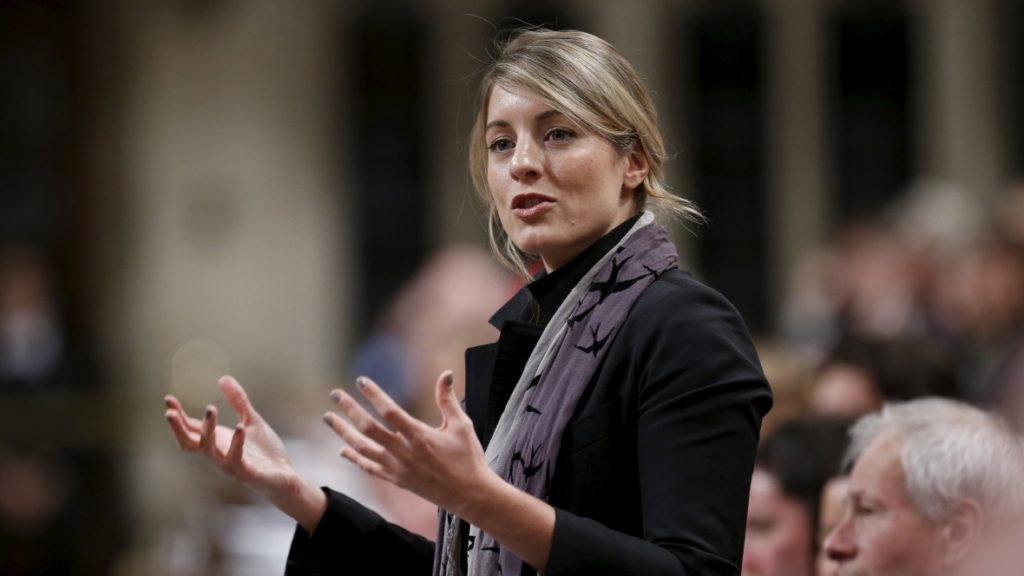 Heritage Minister, Mélanie Joly One reason could be how she has been dealing with Netflix and internet streaming more generally. With virtually unlimited global access through the internet, Netflix and Amazon can be broadcast right into anyone’s home and not be subject to the (HST) as are the TV and cable broadcasters. And by the same token these streaming companies can escape Canada’s outdated domestic content rules.
So the government wrangled some Canadian content into Netflix by getting the US based company to invest half a billion dollars over the next five years into Canadian productions. Details are scarce as hen’s teeth, leaving the impression that this is a deal still at the concept stage. But what about the taxation issue?
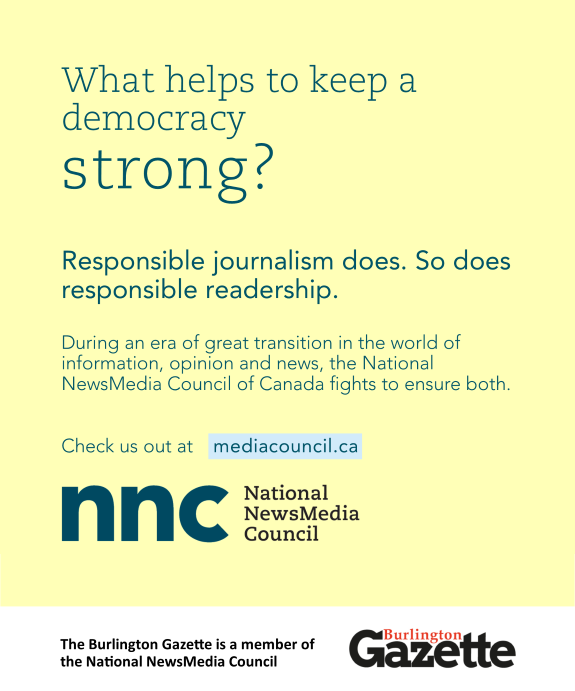 And what was really missing from her announcement is an indication as to how the government plans to deal with the evolution taking place with the daily news. The dailies are a dying breed as advertising revenue, circulation and employment are all in a downward spiral. And once the papers go, so too will the press associations which they support, the ones which provide front-line reporting of events upon which we should all depend. And what was really missing from her announcement is an indication as to how the government plans to deal with the evolution taking place with the daily news. The dailies are a dying breed as advertising revenue, circulation and employment are all in a downward spiral. And once the papers go, so too will the press associations which they support, the ones which provide front-line reporting of events upon which we should all depend.
Some broadcasters like our own CBC utilize their own staff reporters for many stories, and don’t rely solely on the Canadian press service. But broadcast news is also facing challenges, especially in the US, where the president has called what the networks report as ‘Fake News” and has threatened to pull their broadcasting licenses.
Of course he can’t really do that, given the arms length relationship between him and them, and those in that country who do manage media policy. And besides there is that constitutional first amendment. But what he has done with his bluster is erode the public’s confidence in conventional news media and create confusion about what President Trump’s people have called alternate facts.
Those alternate facts have abounded on social media, particularly given the intrusion into the US domestic social networks by the Russians. Even if we disregard those kinds of malicious and fraudulent cyber postings as transitional, there is a plethora of blogs and opinion pieces which masquerade as facts, and serve only to distort the truth.
 American President’s used to hold “Fireside” chats and talk to the public. Donald Trump chooses to tweet and tweet and tweet. Trump, is reported to only watch the Fox News TV channel, a network many mock for its misnomer of a moniker – ‘fair and balanced’. And he prefers to release his own news reports via Twitter from the peace and comfort of his inner sanctum in the White House, rather than at a news conference where reporters can clarify and ask questions. After all, he is the president.
Democracy resides on a three legged platform. Universal suffrage is one leg, the freedom to run as a candidate another. And the free communication of accurate information makes up the final support. Facts are critical, and it is fair game for opinion writers to interpret to their hearts’ content, within the bounds of reasonableness. But there is no such animal as an alternate fact.
 Does Netflix dominate? Canada has been well served by our traditional mixed media, a government owned public broadcaster provides balance to the private paper giants – and they in turn provide a check that the GBG/Radio Canada sticks to the message and doesn’t get seduced by who is providing the pay cheques. Perhaps that is why consideration of this aspect of our communications sector escaped the Heritage minister’s attention.
But even the giants are hurting and there are things a government can do help slow down the bleeding, such as greater advertising purchases. And fair taxation is just as important among the internet and other media as it is for small incorporated business owners.
That is something our negotiators need to keep in mind as they plod their way through these difficult NAFTA negotiations. After all, as the old adage goes, news is what’s in the newspapers.
 Ray Rivers writes weekly on both federal and provincial politics, applying his more than 25 years as a federal bureaucrat to his thinking. Rivers was a candidate for provincial office in Burlington in 1995. He was the founder of the Burlington citizen committee on sustainability at a time when climate warming was a hotly debated subject. Tweet @rayzrivers Ray Rivers writes weekly on both federal and provincial politics, applying his more than 25 years as a federal bureaucrat to his thinking. Rivers was a candidate for provincial office in Burlington in 1995. He was the founder of the Burlington citizen committee on sustainability at a time when climate warming was a hotly debated subject. Tweet @rayzrivers
Background links:
Turkey Talk and Rookie Ministers – Canadian Content – Canadian Content Updating – Canadian Press – Periodical Fund – Newspaper Ask –
Media Funding – Faking News – State of US Media – Threat to First Amendment –

 By Cheryl DeLugt By Cheryl DeLugt
October 12th, 2017
BURLINGTON, ON
The intrinsic nature behind the school closures in Burlington is clearer than most may think. For almost a year now the Halton District School Board (HDSB) has been instrumental in its’ ability to have consistently provided the community a false sense of good intentions when it comes to closing our schools.
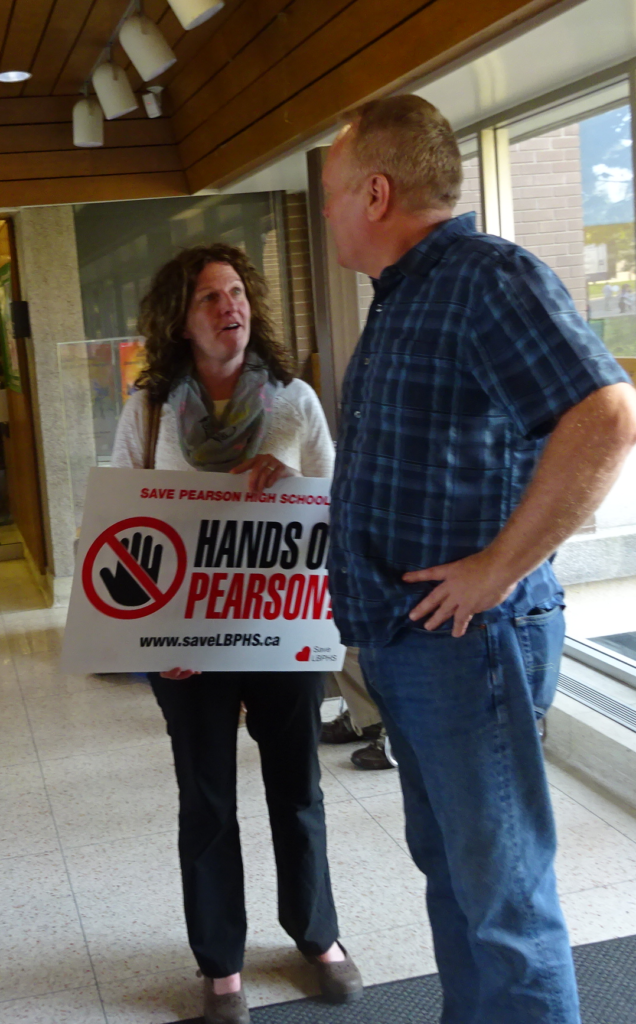 Cheryl DeLugt and Steve Armstrong with the message from the community. Let’s face it….our schools were doomed, some would say…”A Done Deal”. Well, that was at least what was implied by the HDSB and how the majority of the community felt from the very beginning of the Program Accommodation Review Process (PAR). As the PAR process unfolded, it became more evident that closing a school or two was their primary objective.
The mere fact that our school was named and recommended to be closed in advance of any community input or public consultation, made it obvious the board had its own agenda, which in turn became the driving force behind the HDSB efforts to assure their plans to close Burlington high schools were achieved.
It now appears, to many community members, that the whole PAR process was intended to attain a controlled means of community input sufficient enough to claim community participation as part of the Halton District School Boards’ intent and plan to close two Burlington high schools. The process itself lacked honesty, transparency, logic, reason and effective community input. In addition, those who voted on the final decision were elected officials from outside of the affected communities, making the decision to close any schools in Burlington that much easier, or at least easier on one’s own conscience.
Fiscal responsibility to our community was by no means the predominate factor considered when making the decision to close our schools and if it was, a no school closure would have been given equal consideration. The cost savings of closing schools will be in the result of some staff savings and operating costs, but there will be added costs to decommission, insurance, maintenance, that will be added with closure. If one was to look at accounting for all costs, small schools such as Lester B Pearson are in fact more cost efficient on a per capita student basis than larger schools.
 Was Lester B. Pearson high school “doomed” from the beginning? Early on in the PAR process, it was apparent that there was reluctance and obstruction by the HDSB to engage in open and meaningful conversations with the general public and the communities affected by the school closures. This action alone revealed the school board’s lack of transparency and made many residents question the board’s motive for moving so quickly and forcefully to close our schools.
 Kim, a Lester B Pearson high school parent Perhaps the need for a greater emphasis on more open communication and input from our entire community including local and regional officials including the Mayor of Burlington, should have been actively part of the process. The Halton District School Board just recently announced its’ effort in exploring community partnerships now. In an effort of fairness, democracy, and the Ontario Ministry of Education principles, the HDSB had a moral and legal obligation to have explored other creative options more aggressively including possible community partnerships prior to proposing any school closures.
While the HDSB focuses their efforts on the transition process for Lester B Pearson high school and their desires for a “NEW” Administration building, many members of the community will now redirect their attention on the Burlington citizens appeal to the Ontario Ministry of Education now approved Administrative Review (AR).
With the AR soon underway, the need for better collaboration between the City of Burlington, its’ residents, and the Halton District School Boards prior restriction of information and the dissemination of correct, timely information in a transparent fashion will become apparent.
While the Halton District School Board continually reiterates to the public that the Administrative Review will NOT reverse their decision, it should indeed question it to a fair degree. The purpose of the Administrative Review (AR) is to thoroughly review the board’s honest commitment, integrity and ability to follow the HDSB and Ontario Ministry of Education policies while conducting the prior PAR process plus determine if there is need for HDSB procedural change.
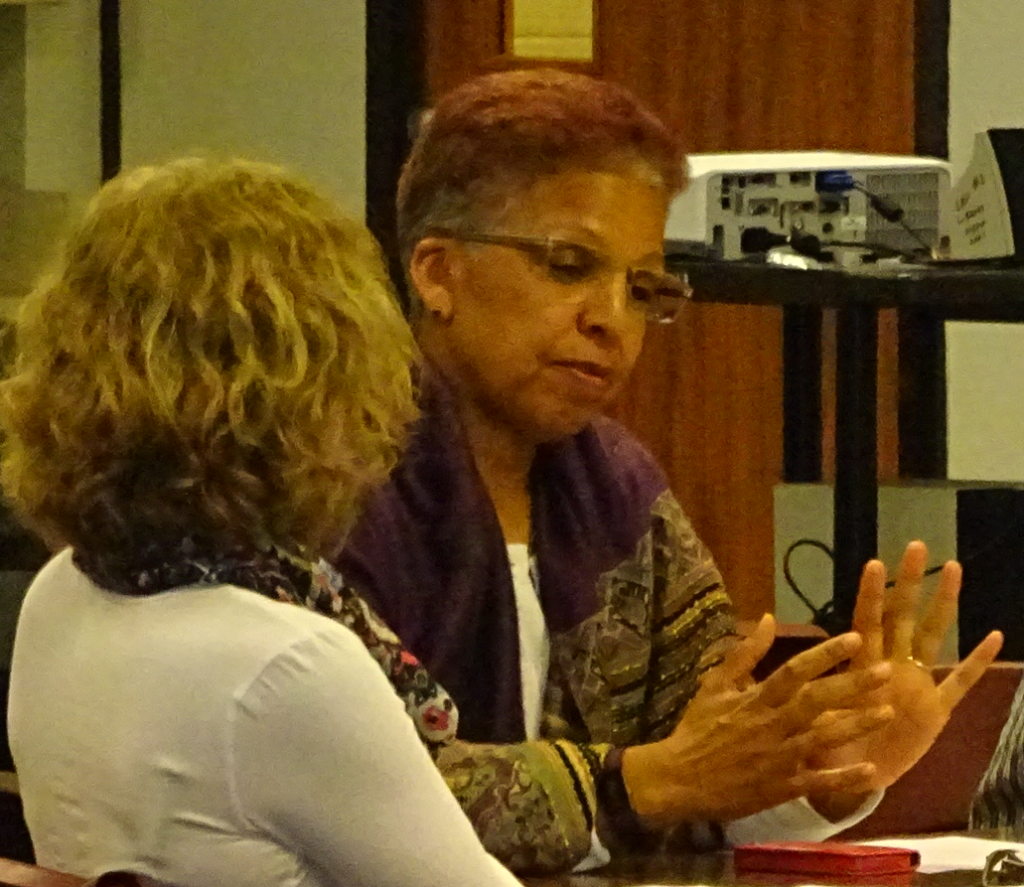 Ward 4 school board trustee Rachelle Papin at a school council meeting. In light of the approval of an AR, and with consideration of the facilitators findings, the community expects our elected Trustees to welcome the opportunity to openly review and change their June 7th, 2017 decision based on newly revealed supportive facts that the process they followed led them to a decision which was indeed without a doubt “flawed”.
After-all, how can and why would any school board or elected official stand behind a decision that they know was made using questionable methods, non- transparency and incorrect information and executed process?
A question we ALL should be asking at this point …especially the school board Trustees.
 Cheryl is a Registered Nurse who was a member of the Program Accommodation Review Committee that was unable to reach a consensus on which if any Burlington high schools should have been closed. Cheryl is a Registered Nurse who was a member of the Program Accommodation Review Committee that was unable to reach a consensus on which if any Burlington high schools should have been closed.

 By George Ward By George Ward
October 7th, 2017
BURLINGTON, ON
Many residents in Burlington are still questioning why we are closing two schools in the growing City of Burlington. The Halton District school Board has presented its perspective and justification for the closures, it still doesn’t make sense.
 Hayden High school, Burlington’s newest built as part of a complex that includes a Recreational Centre and a public library with a skate park across the street. The school is well over its intended capacity and currently has 12 portables. To begin, closing both Pearson and Bateman high school does not alleviate the overcrowding at Hayden (overcrowded with over 1,650 pupils and growing, necessitating the use of 12 portable classrooms and a desire to add 6 more in the future).
Secondly, it does not alleviate the growing pressures on our busing system and in fact contributes to the growing problem and safety concerns. Closing our schools makes absolutely no sense, is unwarranted, unjustified, and simply put is very short-sighted.
The board seems to have lost sight of the fact that schools are public assets and that taxpayers have invested their money in these schools and communities. If one was to look at these school closures in Burlington solely from a financial perspective you would realize that closing Pearson and Bateman will result in a substantially higher costs.
Closing two schools save approximately $2 million, however, some of these operating costs, such as the pool and day care, added busing, and other new ongoing costs to take care of the closed schools are not accounted for. In addition, the costs of capital equipment and facilities to transition specialty programs to Nelson was put at $12 million, but there is concern that this will be much higher. While a no school closure would result in the expense range of approximately $250,000 in operating costs. How is that being fiscally responsible?
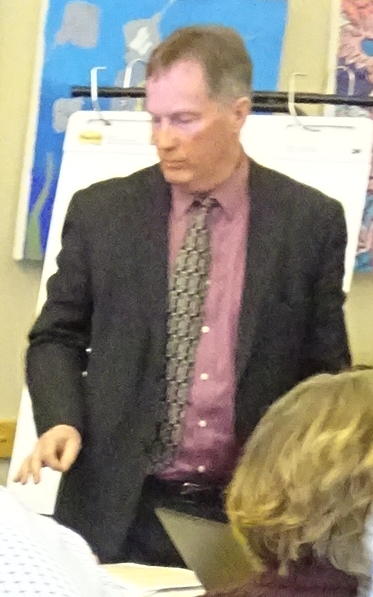 Some of the data that was presented during the PARC meetings was out of date and conflicted with other data put forward. Many had difficulty figuring out just what the full story was. Superintendent of Facilities Gerry Cullen was challenged at times to give a satisfactory explanation. Throughout the Program Accommodation Review (PAR) process, it became clear early on of the lack of transparency when it came to information sharing from the board. From information and data changing periodically to the extensive and lengthy data provided, it became a challenge to gain insight into the facts that led to the decision to close our schools.
With more questions than answers, one might start to wonder: What is the real motivation behind the HDSB wanting to close these schools?
Perhaps when we go back through Board Minutes to understand why the board needs to move forward on school closures in Burlington.
Below is an excerpt from HDSB meeting minutes of February 2017:
The Halton District School Board Administration is experiencing significant growth pressures due to growth in student population and the increasing complexity of its work. As a result, the Board’s existing office facilities have become woefully inadequate. This is not a question of quantity of space, but rather of quality of space.
 It is only a concept but it gives you some idea as to how far along the thinking is within the Boar of Education Administration. Our analysis of how to meet the Board’s current and future needs presents an opportunity to provide the staff of the HDSB with a 21st century work environment: a new 95,000 sq. ft. facility to accommodate 350 staff within a single building, designed according to the guiding principles identified herein.
The sale of the existing J.W. Singleton site would make this project possible and in turn, create a facility that reflects the Board’s values, resulting in the delivery of the highest quality education for the Board’s students.
Budget Estimate: 95,375 sq. ft. x $310/sq. ft. = $29.6M
This estimate is based on the HWDSB (Hamilton-Wentworth) precedent and it is for project costs only. Land costs are not included, as they will depend on the site selection. Space for growth (10,000 sq. ft.. included) is based on HDSB projections, and can be adjusted should projections increase.
Costs:
• 1 move required
• Unknowns could impact the costs include site issues such as geo-technical, soil, zoning,
Benefits:
• Only 1 move – no temporary accommodations required, and minimized disturbance to staff.
• Because this would be a purpose-built environment, it is the option that would best meet the Board’s needs outlined in this report without compromise.
• Other sites no longer in use could be used to raise funds.
It is clearly stated in the minutes that it is NOT a situation of need for additional space but rather a desire for better quality of space. According to the board, a better facility for their staff would in turn provide better education. How does having a nicer work space for HDSB board staff contribute to a better quality of education for our students?
 Demonstrations didn’t make a bit of difference. The trustees, who are the people who made the decision, didn’t hear the parents.  Bateman high school parents chose to give their school a public hug. Shouldn’t priority be that our students have the “best quality learning environment”. Where students can walk or ride their bikes to school instead of sitting on the floor of an overcrowded bus. Where students are able to learn in an environment that is quiet, calm, and not overcrowded, where classes are not held in hallways, where students are not learning in portables, where there is sufficient heating, air conditioning, and/or proper ventilation systems?
The planning for a new Administration office for the Board Staff are moving along: The following comes from a report prepared by a firm of architects. The options before the Board were set out as follows:
Do Nothing,’ but maintain the existing facilities, for an estimated cost of $20M over the next 25 years, with no improvement to the actual offices in terms of functionality or design .
Complete a Renovation- Addition to one of the existing buildings, which would yield a compromised facility with increased disruption, for a similar cost to the final option .
Build a new facility, estimated at
$29 .6M (not including land) is the option that would best meet the Board’s needs as outlined in our guiding principals .
In order to obtain true value and create the desired synergies enabling Board staff to work at their best, we strongly recommend the Board proceed with constructing a new Administrative office facility .
Because of existing legislative requirements, selling the J .W . Singleton property appears to be the best way to generate sufficient dollars to fund this project . This would in turn allow for a new administrative facility to be centrally located in the Milton/Oakville area, where the Region’s growth is projected in the next 25-50 years .
The next phases of this Study will explore potential partnerships that could yield community benefits as well as capital and operating savings . Once specific sites are identified, concept plans, cost estimates and implementation strategies will be completed .
It appears that the need to accommodate 350 board staff takes precedence over the 76 elementary schools, and 17 secondary schools that serves over 50,000 students, excluding those in adult, alternative, and Community Education program within our school system.
Despite the fact the Minister of Education announced a moratorium on the Program Accommodation Review process and the fact that the HDSB is now subject to an Administrative Review, the HDSB continues to move forward on their plan to close two Burlington high schools, despite the fact the process that led to the decision has been publicly deemed to be flawed.
So, the question still remains.
Why is the HDSB really closing schools in Burlington?
Related article:
School Board announces it is looking for partners.
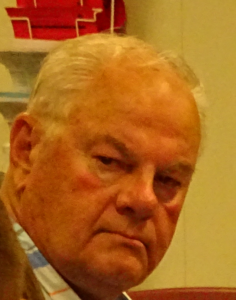 George Ward is a semi- retired quality control auditor who is deeply involved in the community effort to keep the Lester B. Pearson high school open. Both his children and some of their children attended Lester B. Pearson. George Ward is a semi- retired quality control auditor who is deeply involved in the community effort to keep the Lester B. Pearson high school open. Both his children and some of their children attended Lester B. Pearson.

 By Ray Rivers By Ray Rivers
October 6, 2017
BURLINGTON, ON
I’ve heard it said that Tom Mulcair would have won the last federal election if only he’d shaved his beard. But I guess the NDP rank and file missed that barb, since they have just chosen a new leader with an even more impressive facial mane.
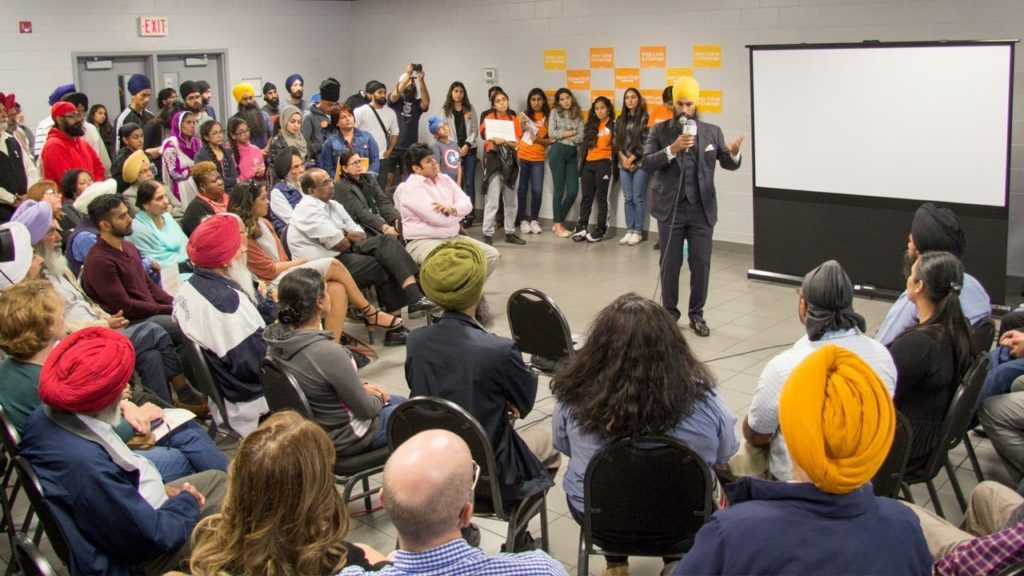 Singh organized his community and brought in far more new members than any other leadership candidate. Now to see what he has in the way policy ideas. Jagmeet Singh won the federal NDP leadership on the first ballot. And of course he did! He had signed up over a third of the NDP membership and most of the others didn’t even bother to vote. Who can blame them? Of all of their previous leaders only Layton gave the membership hope of winning the top prize. And after the last election they are back to where they started.
 The Minister of Defence wears a turban – not as colourful but something we have accepted in most parts of the country. So the old NDP was ripe for a change, needed to do and be something different. And no candidate less represented the good old losing days than the 38 year old lawyer and MPP from Brampton. There was a buzz about this articulate young snappy dresser, even with that colourful turban he dons, which unfortunately reminds one of the TV cartoon character Marge Simpson.
He had the numbers and ran a winning campaign, at least within the confines of the NDP. The old guard in the party either gave up or went along for the ride, tired and hopeless, after the unexpected whopping they experienced at the polls last time around. And with a new leader and so many new members, almost a tripling of the membership, this is truly a ‘New’ Democratic Party.
Yet despite all the buzz about this new whiz kid they’ve chosen to follow, he hardly seems ready for the job of PM. For one thing he is reluctant to sit in the House of Commons, at least until the next federal election in 2019. That would make him a bit of a ‘pig-in-a-poke’ come the time to cast our ballots. You’d think Singh, himself a master of martial arts, would be itching to step into the ring, to flex his muscles and to take on the current knock-out champ?
 Jagmeet Singh is colourfull both in dress and character and very intense. Perhaps the real reason is that his policy envelope is nearly empty when it comes to anything but social policy – immigration and racial equality in particular. Of course that is his background, as a defence lawyer and MPP, where his main claim was pushing the Wynne government to end the practice of police racial carding.
His religion obviously plays a big part in his life given how he dresses and what he fights for. For example, he advocated for Sikh motor cyclists wanting to be exempted from wearing helmets, because they didn’t want to remove their turbans. Was Singh placing his religious preference over public safety?
Sikhs make up less than 2% of Canada’s population though they have proven to be a powerful political force in their own right. How else would one explain how their children are allowed to bring ceremonial daggers to school with them, or how they alone among recruits can override the RCMP dress code? It is a religion of peace, but then aren’t they all?
Some will want to draw comparisons between Singh and Obama, another leader of a major political party, representing a visible minority and campaigning to deliver social equity. A key difference is that with Obama, faith was between him and his maker, but Singh’s is conspicuous. That can be both a strength and a shortcoming.
Already there are concerns about how he will be received by the average voter in Quebec, and whether he will be able to ever win back all those Jack Layton voters who went to Justin. Quebecers generally disapprove of the blatant display of religiosity, be it by Muslim, Hassidic Jew, or even by the more traditional Catholics. And without Quebec how can he ever hope to form the government in Ottawa?
Perhaps that is how it was meant to be. For in the history of Canadian politics the NDP has always been that bridesmaid, not the bride, the king’s advisor but never the king. The social democratic movement’s greatest gift was when the CCF pioneered single payer health care, though they have also left their imprint in many other areas of public policy.
Still wherever the NDP has formed provincial governments, even in Ontario, they aspired towards mostly pragmatic and middle-of-the-road policies, much like the Liberal governments they sometimes replaced. And that is the problem. There is already a progressive Liberal party – why does Canada need two?
Nobody soft-shoed around socialism more than former NDP leader Mulcair, plunking himself in the middle between a rightish Harper and a leftish Trudeau. And he lost big time. Would his party’s showing have been any worse had he just stood up for what his party is supposed to represent?
 Will the turban be something that Canadians take to? Notwithstanding their new leader, the best the NDP can ever expect is to continue to be a third party, hopefully the party of Canada’s social conscience. Their dream of ever becoming the government was thrashed when they scuttled Trudeau’s plan for a preferential ballot, forcing him to entirely pull the plug on electoral reform.
With our first-past-the-post system now secured into the future, there will certainly be opportunities for third parties in the next minority government. And that may come as soon as 2019. But it all will depend on just how well Mr. Singh plays his cards in the great game of Canadian politics.
 Ray Rivers writes weekly on both federal and provincial politics, applying his more than 25 years as a federal bureaucrat to his thinking. Rivers was a candidate for provincial office in Burlington in 1995. He was the founder of the Burlington citizen committee on sustainability at a time when climate warming was a hotly debated subject. Tweet @rayzrivers Ray Rivers writes weekly on both federal and provincial politics, applying his more than 25 years as a federal bureaucrat to his thinking. Rivers was a candidate for provincial office in Burlington in 1995. He was the founder of the Burlington citizen committee on sustainability at a time when climate warming was a hotly debated subject. Tweet @rayzrivers
Background links:
NDP Election – More NDP – Sikhs on Bikes – Singh Bio –
Police Carding – Sikhism – Trudeau’s Worst Nightmare –
Singh Interview – Leadership Race – Quebec – Absentee Leader –

“MY STYLE of deal-making is quite simple and straightforward. I aim very high, and then I just keep pushing and pushing and pushing to get what I’m after.” ― Trump: The Art of the Deal
 By Ray Rivers By Ray Rivers
September 28th, 2017
BURLINGTON, ON
The first push, tariffs the US imposed on Canadian softwood lumber, hit us only a couple of months ago. This is not the first time the US has attempted to disrupt trade on this file. But it’s an easy target since Canada virtually owns the US market for imported softwood.
Another pressure point is Canada’s supply management systems, notably dairy. The US dairy corporations would dearly like to break open this market to their products and help alleviate the subsidized over-production of milk products stateside. This even though American dairy farmers are already net exporters to our country.
 Boeing wants to do everything it can to protect its markets world wide – keeping Bombardier out o their market is one part o that process. And this week there was a whacking 220% countervail duty imposed on Bombardier’s new passenger plane being sold to Delta airlines. Quebec’s one billion investment in our modest aircraft maker apparently ticked off mighty Boeing Corporation who isn’t even competing in that market. And Boeing itself is in a he-said-she-said battle over subsidies with European Airbus, given the billions of bucks it gets from US and state governments.
It’s the ‘art of the deal’. Trump’s strategy to help make America great again involves having your cake and eating it too. And flexing muscles is all part of the game. If he can hurt us enough then maybe we’ll give in to US demands to restructure NAFTA to America’s advantage; American courts, guaranteed US content in imports and none of that environmental, aboriginal or gender nonsense.
To be clear NAFTA is a free trade agreement in name only. Unlike real free trade as they have in the EU, the North American entities still maintain customs at the borders and mostly restrict labour movement. Even so, there is overwhelming proof that the ‘three amigos’ trade deal has been successful.
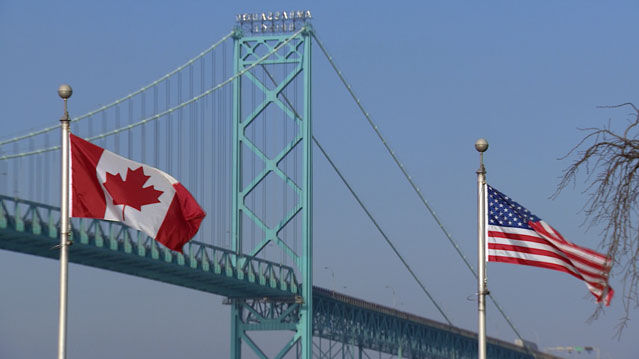 It’s tough to maintain a strong positive trading relationship with a partner, the President of the United States, that doesn’t understand and is probably unfit for the job he holds. It has helped grow all three members’ economies and has lifted Mexico’s standard of living the most. In fact economic growth there has helped curtail and even reverse the flow of illegal immigrants into the US. It is unfortunate that the US president fails to appreciate the irony in that NAFTA has done more to stop illegal Mexican immigration into his country than his border wall ever will.
The USA is neighbour, good friend and biggest trading partner so the Canadian and Mexican governments have been careful in responding to all the turbulence and chaos they’ve seen recently whether in trade, environment, immigration or other global affairs. Canada’s response to the softwood lumber assault was measured and cautious, relying on mechanisms that have served us well in the past.
The challenge is to stay calm and avoid a real trade war, in which case nobody wins. This is just a negotiating strategy after all, led by your above average American real estate tycoon, the man who wrote the book. After all, tearing up NAFTA would hurt everyone in our relatively integrated North American industrial economy, even if it might proportionally hurt Canada and Mexico more in the short run.
One would think even Trump would get that. But he doesn’t because free trade is incompatible with an ‘America First’ protectionist doctrine. The principle of comparative advantage, which underlies the very idea of free trade, is a sort of zero sum game. When everyone wins, America wins. It really is a little different than managing a casino where only the Casino owner wins.
 The Boeing aircraft manufacturing company would like to sell their Super Hornet fighter aircraft to Canada. We need new military airplanes. But they don’t want to allow a Canadian company to sell their aircraft into the American market. Nice people. Canada does have to respond, as part of the negotiation game, and we have the means to effect some damage. No super hornets is an obvious first step. Joining the Europeans, our latest free trade partners, in their ongoing confrontation over who subsidizes more – Boeing or Airbus – is a no brainer. And we should consider countervail on any Boeing sales here if we can prove it.
But we need to remember that Boeing also employs Canadians and that US presidents come and go and the next one may be a free-trader for a change. Still NAFTA is tired and in need of an update. It is time to scrap that overreaching ‘investor-state’ provision for starters.
The entire trade deal needs to be built around environmental considerations with appropriate measures for protection, including mitigating climate change. And there can be no real free trade in services without free mobility of labour and common labour standards. This is the cornerstone of the EU and its free trade area.
Free trade is a neoliberal concept and one that most conservatives applaud because of the opportunity if offers to better the business case. But Donald Trump is neither a neoliberal nor a conservative – he is just Trump. And it is doubtful that he really understands that running a perpetual trade surplus, even if the US could, is every bit as unsustainable as running an on-going deficit.
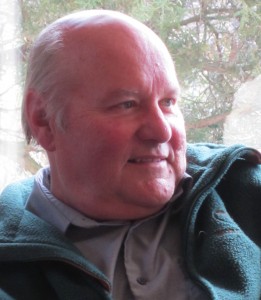 Ray Rivers writes weekly on both federal and provincial politics, applying his more than 25 years as a federal bureaucrat to his thinking. Rivers was a candidate for provincial office in Burlington in 1995. He was the founder of the Burlington citizen committee on sustainability at a time when climate warming was a hotly debated subject. Tweet @rayzrivers Ray Rivers writes weekly on both federal and provincial politics, applying his more than 25 years as a federal bureaucrat to his thinking. Rivers was a candidate for provincial office in Burlington in 1995. He was the founder of the Burlington citizen committee on sustainability at a time when climate warming was a hotly debated subject. Tweet @rayzrivers
Background links:
Art of the Deal – Softwood – More Softwood – Boeing-Bombardier –
More Bombardier – After NAFTA – Boeing Subsidies –
Canada-US Trading – Neoliberalism –

 By Staff By Staff
September 26th, 2017
BURLINGTON, ON
Frequently our readers make the case for change and wonder why the bureaucrats are not on top of the task?
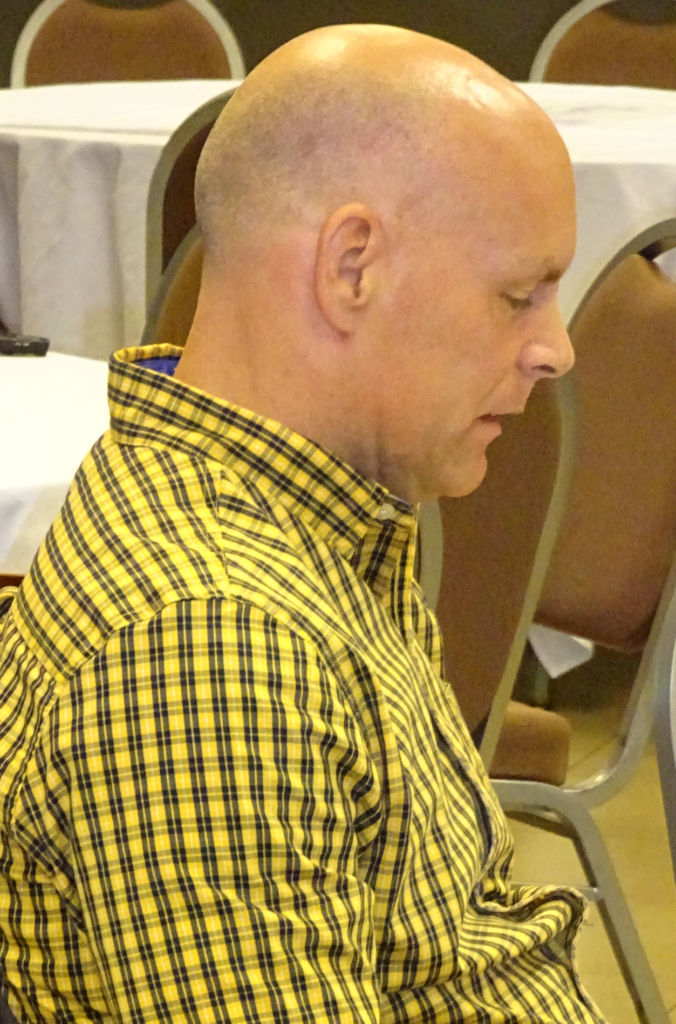 Kevin White Ken White, an Alton Village resident, makes a significant point when he comments on the push to intensify and get people out of their cars and onto public transportation or their bicycles.
Here is his comment:
“The Provincial Intensification target was in part meant to promote public transit to accommodate housing density. This was to reduce greenhouse gases and add a mix of affordable housing.
“Fast forward to Burlington and as evidenced by the Committee of the Whole council took part in on September 7th.
“We learned then that we essentially don’t have a transit plan and in fact Burlington Transit will require years of intense investment to bring it to the point of sustainability.
 The city doesn’t have a capital budget for transit – relies on part of the gas tax they get from the province and the federal budget. “A total failure of project management where transit is working in one silo and planning is working in another.
“Frankly, if you can’t convince anyone that you can move this intensified city then you have no business adding population in the first place.”
Is this the first look at a citizen thinking about elected public service?

 By Pepper Parr By Pepper Parr
September 22, 2017
BURLINGTON, ON
They decided to work as a tag team in the House of Commons during Question Period yesterday.
First Oakville North Burlington MP Pam Damoff stood and asked:
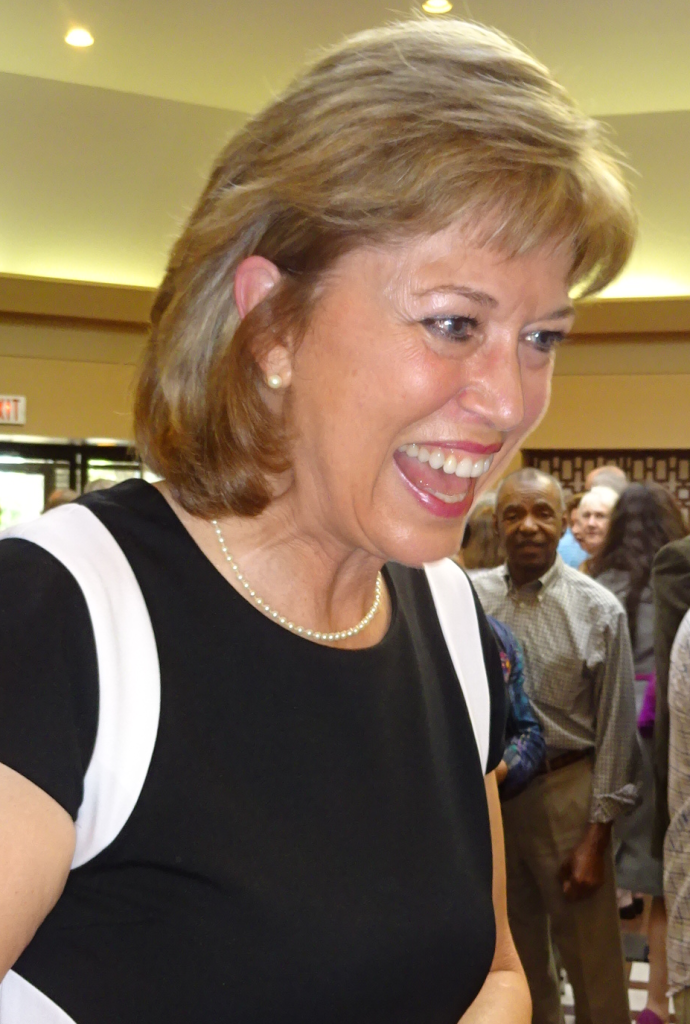 Oakville Burlington North MP Pam Damoff “Mr. Speaker, the Leader of the Opposition has stated that he feels he should not be bound by the same ethical standards he demands of others in the House. He may have forgotten that his own party’s changes to the Lobbying Act actually make him a designated public officeholder. This might explain the confusion about the Leader of the Opposition hosting secret fundraisers.
“Could the Minister of Democratic Institutions tell the House what she is doing to pull the curtain on these types of fundraisers?”
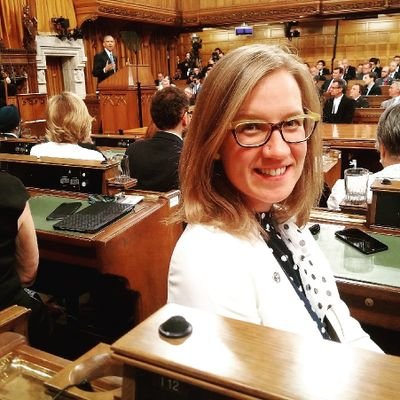 Burlington MP Karina Gould getting her picture taken while former President of the United States addresses the House of Commons. The Minister of Democratic institutions, Karina Gould, the Burlington MP stood up and responded thusly”
“Mr. Speaker, Canadians have a right to know about fundraising events attended by party leaders and leadership candidates, as well as the Prime Minister and cabinet ministers. Our legislation will make public the information related to who is going to fundraisers, where and when they are happening, and the amount required to attend.
“We hope the opposition will support this bill in committee so that no opposition party can ever again have their leader hold secret fundraisers.
“Together let us all raise the bar.”
Words to be remembered.

 By Ray Rivers By Ray Rivers
September 20, 2017
BURLINGTON, ON
Were they set up or just naive? To be a candidate for the Ontario Liberal Party one has to be approved by the Leader of the Party. So how did this by-election in Sudbury become such a mess?
Liberal candidate Andrew Olivier had narrowly missed winning a Sudbury seat in the 2014 provincial general election. So when the seat became vacant a year later, he naturally assumed he’d be the automatic choice for the party. But the Premier had promised the nomination to someone else, a better candidate in her mind, Glenn Thibeault, the federal NDP member for the riding who was willing to leave the federal arena and change parties, presumably for a good reason.
 Ontario Energy Minister Glenn Thibeault with Burlington Hydro president Gerry Smallegange looking over the map showing where the outages were during the 2015 snow storm. Thibeault won the election handily, slipping past the NDP provincial candidate and trouncing Olivier, who had no choice but to run as an independent. Thibeault must have met the Premier’s expectations because she later moved him into her Cabinet as energy minister, giving him the hot energy file and the job of developing the province’s long term energy plan.
No doubt Olivier was sore about not having got the nod to run a second time under the red banner, but under provisions of the Liberal Party’s constitution the leader is pretty much allowed to appoint any candidate she chooses, especially in a by-election. And then, as we know, hell hath no fury like a spurned political candidate. So somebody in the Party needed to talk him down in case he walked right out of the Liberal camp with all his supporters. And that is when it all got messy.
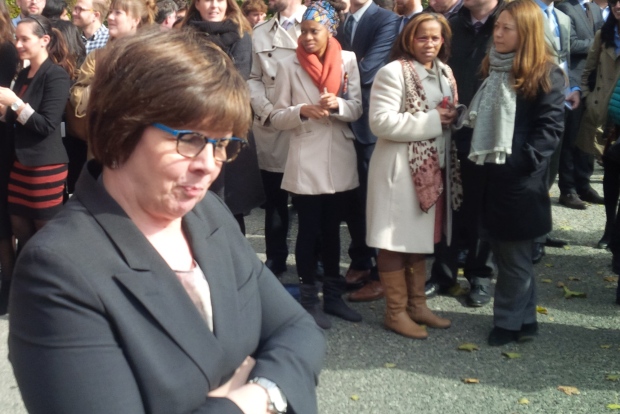 Pat Sorbara, major force in the Premier’s office has to resign and defend herself in a Sudbury court room And when the Premier’s chief of staff, Pat Sorbara, and a local Liberal organizer, Gerry Lougheed, spoke with Olivier, he recorded their conversations. He claims they had offered him a job or appointment. But instead of being placated by their apparent concern for his economic future, he took his recordings to the nearest cop shop.
Apparently Olivier knew something they hadn’t considered. There is a 1998 provision of the Ontario Elections Act….”96.1 No person shall, directly or indirectly, (e) give, procure or promise or agree to procure an office or employment to induce a person to become a candidate, refrain from becoming a candidate or withdraw his or her candidacy. 1998, c. 9, s. 44.”
Provincial MPPs may be elected locally and they are expected to serve their local electorate. But a Cabinet minister governs for the entire province and not just his/her constituency. And that can be a good reason for a party leader to have the authority to appoint a candidate.
Nomination meetings can become popularity contests where family and friends, and in some cases a whole community arrive in droves. And this wave of ‘instant’ party members can propel the favourite son or daughter on to victory as the chosen nominee. ‘Instant’ because they weren’t party members before this event, nor likely will be again.
None of this should imply that the most popular candidate is not the best or the best qualified. But just in case, the party always vets, the Leader has the final say and sometimes she/he appoints rather than allow a nomination meeting. The Premier wanted Thibeault for her Cabinet – her choice, her call. Anyone who meets the basic qualifications can run for provincial office, but those running under a party’s banner need to be blessed by the leader.
 Liberal party organizer in Sudbury – Gerry Lougheed Sorbara and Lougheed have been criminally charged and the case is now before a judge. There will be a determination as to whether what the party did amounted to bribery or whether the accused were just offering Olivier a gesture, a consolation prize after the fact. Even if the judge dismisses the charges, this will be an important lesson and precedent for the future.
Apparently Olivier wasn’t offered public service employment – which requires merit testing – or even a specific job or appointment at all. But the point is that Sorbara and Lougheed didn’t even need to talk with him, and you can bet they wish they hadn’t. The upshot, no matter how the judge rules, is that the Premier and her party will take a hit for something that could have and should have been avoided.
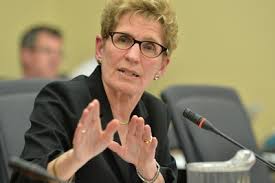 Telephone calls that didn’t ave t be made were made – might cost Premier Wynne the June 2018 election. The one thing that might keep her in office is the quality of the other choices. Olivier stands to gain little if anything out of this case except the personal satisfaction of knowing that he has cost the accused their jobs and knowing that he may have hurt the Premier as she approaches another election next year. The notoriety of the case may help or hurt him with his political ambitions. And who knows, one day he may get to sit in the Pink Palace? But it won’t be as a Liberal.
 Ray Rivers writes weekly on both federal and provincial politics, applying his more than 25 years as a federal bureaucrat to his thinking. Rivers was a candidate for provincial office in Burlington in 1995. He was the founder of the Burlington citizen committee on sustainability at a time when climate warming was a hotly debated subject. Tweet @rayzrivers Ray Rivers writes weekly on both federal and provincial politics, applying his more than 25 years as a federal bureaucrat to his thinking. Rivers was a candidate for provincial office in Burlington in 1995. He was the founder of the Burlington citizen committee on sustainability at a time when climate warming was a hotly debated subject. Tweet @rayzrivers
Background links:
Ontario Elections Act – Ontario Liberal Constitution – Sudbury Riding –
Legality of Recording Evidence – Timeline

 By Pepper Parr By Pepper Parr
September 16th, 2017
BURLINGTON, ON
In the near future there will be an announcement on the appointment of a Facilitator who will review the request for an Administrative Review of the Halton District School Board trustee decision to close two of the city’s seven high schools.
There was a request from the parents at Pearson high school and a request from the parents at Bateman high school for Administrative reviews.
The bar to getting a review was not low – the parents had to show they had wide community support.
The Facilitator will meet with each parent group and meet with the Board of Education staff for reaction from them.
And in the fullness of time there will be a response.
What if – the Facilitator decides there was enough wrong with the process and recommends that the PAR be done again?
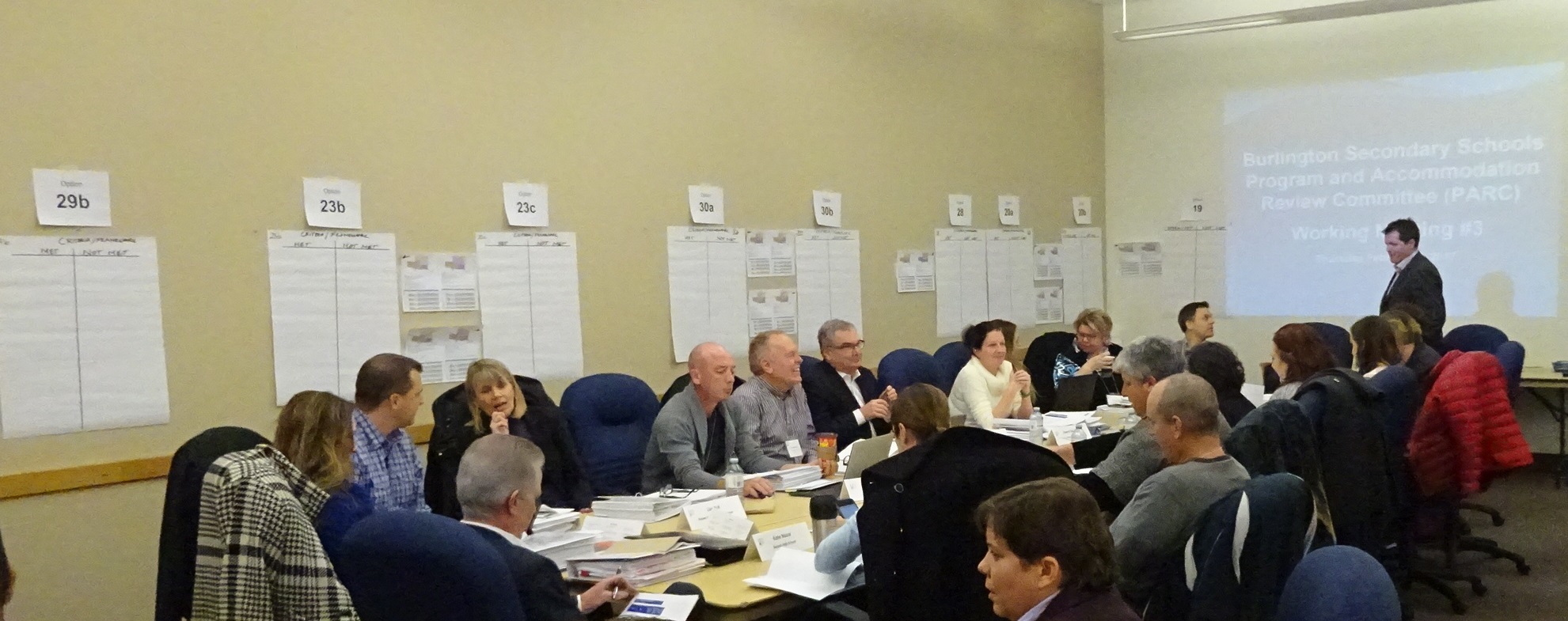 Would another PAR Committee be formed? The Board would, we think, have to create a new Program Accommodation Review (PAR) and put a new recommendation forward. Would a new recommendation be any different than the first which was to close Pearson and Central and then revised to close Pearson and Bateman?
Assume all this happens.
Would the current Board of Trustees act any differently?
The power to make a decision exists at the Board of Trustee level and that group does not appear to be in touch with the sentiment in the community.
Unfortunately the Burlington communities are quite fractured – making it difficult for the trustees to make a decision.
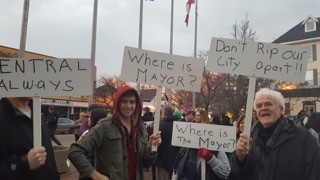 The Central parents were out early and they spared no effort to make sure they told their story. Central high school parent care only that their school not be closed. They put forward very solid arguments and did a superb job of rallying the parents and focusing the concerns.
The Pearson parents didn’t have anywhere near the resources that Central had and there was a lingering unwillingness to be as bold and as forward as the Central parents were.
The Batman parents failed to read the tea leaves.
The issue the trustees were given was that Burlington has 1800 classroom seats with no students in them. (We appreciate the 1800 number is debatable.) If this was true, it was evident the moment the first map showing where the high schools were located that Batman was at significant risk. They failed to see that until their name was on the list of schools to be closed and while they have done a decent job of getting their story out they have not shown an ability to work with the Pearson parents and create a united front.
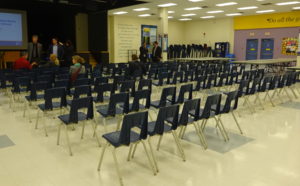 That empty room was a damaging and telling statement made by the Bateman parents. The Bateman grievances are real. They have every reason to feel that they have not been heard. Part of the reason is they didn’t say very much early in the game when it counted.
Given all the turmoil within the different parent groups is it any wonder that the trustees took the safe route and went with the recommendation they were given by the Director of Education?
There was within all the options put before the trustees one that would have given the community the time it needed to take a long hard look at just what Burlington has in the way of high schools and what it needs now and what will be needed ten years from now.
 Option 7 – close no schools – was on the table but it didn’t get a lot of support from the PARC – this tally was 8 out of 14. Option number 7 was to not close any schools and take some time to determine just what future needs were going to be. Much of the data the Board staff put forward was suspect and didn’t stand up to the scrutiny the PAR tried to impose.
The public may have expected the trustees to make that kind of decision – the current board of trustees just isn’t up to that task.
Someone is going to have to come forward and pull the parent groups together and hammer out what they collectively want and take whatever consensus they can find to the Board administration and the trustees.
And then begin looking for trustee candidates across the Region to fill those seats with people who are up to the task.
Salt with Pepper are the opinions of the publisher of the Gazette

 Ray Rivers Ray Rivers
September 15, 2017
BURLINGTON, ON
One only pays income taxes if one has some kind of income. The more income one has, the more taxes he/she can afford to pay. Canadians agreed a long time ago that it is only fair that the wealthy pay a greater share of the tax burden, commensurate with their greater income. So our income taxes are progressive, meaning that the percentage of income being taxed rises with earnings.
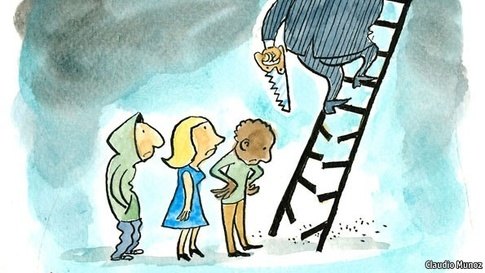 Tax ladder Over the last several decades however, it has all gone awry. The richest one and/or ten percent of us continue to grow their share of the economic pie at the expense of the rest of us. And the spread between the upper and lower classes continues to grow wider while governments cut income tax rates and rely more on sales taxes (HST) for their revenues. Sales taxes are regressive in that they hurt the lower income folks more than the wealthiest.
 Robin Hood – Not a model any government wanted to use. Income taxation is not only the fairest from the perspective of equity, but also the most efficient in terms of economic growth. According to the early British economist Sir Robin Hood stealing from the rich to give to the poor favours economic growth simply because the poor spend more of the money they have than do the rich. Of course Sir Robin’s theory flies in the face of now disparaged right-wing gospel song titled ‘trickle-down-economics’, in which giving more money to the rich was supposed to eventually trickle down over the tops of their boots to the poorer people down below.
Mr Trudeau came to office with a promise to restore the middle class in this country and he knows appropriate taxation lies at the heart of that promise. So in his first budget he made the tax system more progressive by adding more tax classes and marginally increasing the rate the biggest income earners have to pay, while even more marginally reducing the ones at the lower end.
He also campaigned to reduce unfairness in the tax system by closing loopholes. So the other day his finance minister Mr. Morneau announced they were going to curb the way in which small incorporated business owners have been avoiding taxation by misrepresenting the costs of doing business – sprinkling payments to family members who don’t actually work in the business.
Of course everyone of us believes in getting rid of tax loop holes and believes in tax fairness. That is, until our own ox gets gored, the hens come home to roost, or whatever it is we say on the farm. So small business people, and most notably doctors are screaming blue murder that they’ll have to pay more taxes if this loophole is eliminated. And they have their rationale, indeed as we all do. But unless you are a doctor you can’t possibly understand how hard it is to get by on what doctors make, even the ones who opt to be paid a salary.
 The truth is that our tax system is a mess, a morass of loopholes and tax exemptions which have crept up on us like cobwebs in an untidy garage. Successive governments kept gluing on these addenda, primarily doing their best to serve the needs of the country, and too often and sadly, serving the needs or their electoral base in spite of the country. The truth is that our tax system is a mess, a morass of loopholes and tax exemptions which have crept up on us like cobwebs in an untidy garage. Successive governments kept gluing on these addenda, primarily doing their best to serve the needs of the country, and too often and sadly, serving the needs or their electoral base in spite of the country.
Like everything governmental there is a political perspective to the tax system. So we retain popular personal deductions when that function could mostly be replaced simply by raising the minimum level at which people have to start paying taxes. If the politicians would agree to making our Canada Pension Plan a genuine livable pension, RRSP’s and private pension plan contributions could be eliminated as deductions. And of course broadening our health insurance system and adding dental coverage to our social programs would eliminate those health deductions from needing to appear on the tax form.
A dollar of income is a dollar of income, right? So why not treat all sources: employment earnings, net business income, bank/investment interest, dividends and capital gains the same? And why don’t we tax the other incomes, from windfalls such as lotteries, gambling and inheritance? Interestingly a professional gambler does need to pay taxes on his/her winnings, though he/she can also claim eligible business deductions.
 Aside from the loopholes and the degree of progressivity, there is the whole tax filing process. Once upon a time we could get by by mailing in a measly four sheets of paper and a couple T-4s. Today’s return requires reams of annexes and tables up the wazoo. There are now literally dozens of private sector computer-based and on-line packages and they are all just different enough to make them proprietary, though they all claim to be accurate. Aside from the loopholes and the degree of progressivity, there is the whole tax filing process. Once upon a time we could get by by mailing in a measly four sheets of paper and a couple T-4s. Today’s return requires reams of annexes and tables up the wazoo. There are now literally dozens of private sector computer-based and on-line packages and they are all just different enough to make them proprietary, though they all claim to be accurate.
In fact the government has stopped mailing out tax filing packages so one practically has to buy a package anyway, or hire a tax accountant. Complexity had made the long tax form obsolete. Nobody can file that way unless they have at their disposal a computer, calculator, abacus and rabbit’’s foot, perhaps not in that order.
So it is hard to argue against Mr. Trudeau taking on the long overdue and thankless job of reforming a system which was last re-invented in the late 1980’s when Brian Mulroney sought to give us a taste of his notion of tax simplification. However, the approach Mr. Trudeau is taking is piecemeal at best, a sort of facelift when what is really required is major surgery.
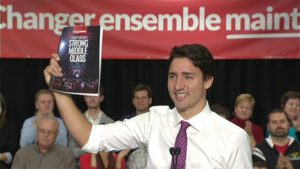 Might one speculate that the Liberals are hoping the changes they are making, like decorating a house room at a time, will be harder for any subsequent Conservative government to dismantle and discard? Or perhaps the task of tearing down and reconstructing the entire building at one time is just too daunting for a government nearing the middle point in its term in office. In which case we can only hope that there is a master blueprint for the design of a better castle or implement shed. Might one speculate that the Liberals are hoping the changes they are making, like decorating a house room at a time, will be harder for any subsequent Conservative government to dismantle and discard? Or perhaps the task of tearing down and reconstructing the entire building at one time is just too daunting for a government nearing the middle point in its term in office. In which case we can only hope that there is a master blueprint for the design of a better castle or implement shed.
 Ray Rivers writes weekly on both federal and provincial politics, applying his more than 25 years as a federal bureaucrat to his thinking. Rivers was a candidate for provincial office in Burlington in 1995. He was the founder of the Burlington citizen committee on sustainability at a time when climate warming was a hotly debated subject. Tweet @rayzrivers Ray Rivers writes weekly on both federal and provincial politics, applying his more than 25 years as a federal bureaucrat to his thinking. Rivers was a candidate for provincial office in Burlington in 1995. He was the founder of the Burlington citizen committee on sustainability at a time when climate warming was a hotly debated subject. Tweet @rayzrivers
Background links:
Tax Fairness – Morneau’s Changes – Tax Reform –
Taxes and Growth – Tax Consultations – Capital Gains Taxation –

 By Joe Gaetan By Joe Gaetan
September 14th, 2017
BURLINGTON, ON
In order to understand why Prime Minister Justin Trudeau and Finance Minister Bill Morneau are on the wrong track when it comes to small business taxation, Joe Gaetan explains that they have to understand what small businesses are all about, how they tick, the challenges they face and the risks they take.
“According to government statistics, approximately 80,000 new small to medium sized businesses (SME’s) are born and about 80,000 cease to exist each year.
 Where does your funding come from? “To start a business you need seed money, in 2014, 51.3 percent of SME’s sought external financing, compared with 48.7 percent that did not request external financing. If a small business owner funds his or her own business they are doing it with after tax dollars, something many people forget. If they borrow from a bank they will have to collateralize the loan which means if things go awry they could lose their home. Lacking both a credit history and the collateral needed to secure a loan, over 80 percent of start-ups face great risk by personally financing their new businesses. On top of that one should know that small business owners (SBO’s), doctors, farmers, restaurant owners are not tax cheats.
 Retirement is not a sure thing. “SBO’s have no pensions, let alone indexed pensions, no stock options with generous tax treatment, no health benefits, no sick day benefits, no vacation benefits, no golden parachutes and no help from Provincial and Federal politicians. When it comes to vacations and sick days, small business owners lose income when they are away, but their expenses continue and they usually experience a drop in income for however many days they are away. Generally speaking small business owners have no entitlements and no security blankets to get them through any rough patches. The same cannot be said for government workers, politicians, teachers and employees of many public and private enterprises.
“The government recently issued a 63-page white paper on small business taxation that requires an in-depth understanding of tax law, something most small business owners do not have. The paper targets, income sprinkling (income splitting), earning passive investment income in a corporation and converting a corporation’s ordinary income into tax-preferred capital gains, using net income examples that any business person would be happy to enjoy, but is far from representative of small business net-income .
“The article states that,” income sprinkling” (a catchy term used by Morneau to denigrate what is really income splitting),“is perhaps deemed the most offensive” and “the one that will likely have the broadest financial impact on small business owners and incorporated professionals”. The latter is an understatement if there ever was one.
 They don’t exist in the private sector where the Small Business people thrive. “Large banks or any large corporation for that matter, can put whomever they like on their board and can sprinkle them generously with stock options, that when exercised are favorably taxed, one could say “that” practice is a major loophole, but it isn’t, it is perfectly legal under our tax code. Why? Stock options usually carry a 10-year life span which allows the grantee the luxury of exercising them when the time is right and when exercised, only 50% of the gain is taxable. In lay terms, imagine how happy you would be if only half of your income was taxed.
“This is costing the government and therefore us about $800 million a year in lost tax revenue, but the government would sooner tax the small business owner.
“At present small business owners can share part of their income with their board of directors. That could include one or more members of the family, including their spouse and children. Money taken out by a family member would be taxed at the rate for the person who benefited from the income. The family member in question may have little or a lot to do with the day to day operation of the business. One of the arguments against this is, small business owners use this money to put their kids through school, but what about the free tuition that is granted to children of university employees, is that not the same thing, is that not a non-taxable benefit and therefore a loophole that needs to be plugged?
“To understand the full impact of the impact of the attack on “earning passive investment income in a corporation and converting a corporation’s ordinary income into tax-preferred capital gains, you should know that prudent small business owners keep between 90 to 180 days of cash in the bank to get them through low business cycles and unexpected events like Sep 11, 2001 or 2008, two events in recent times that had a negative effect on small and large businesses. Except the “too big to fail companies” were helped while small business had to surf through it with zero help.
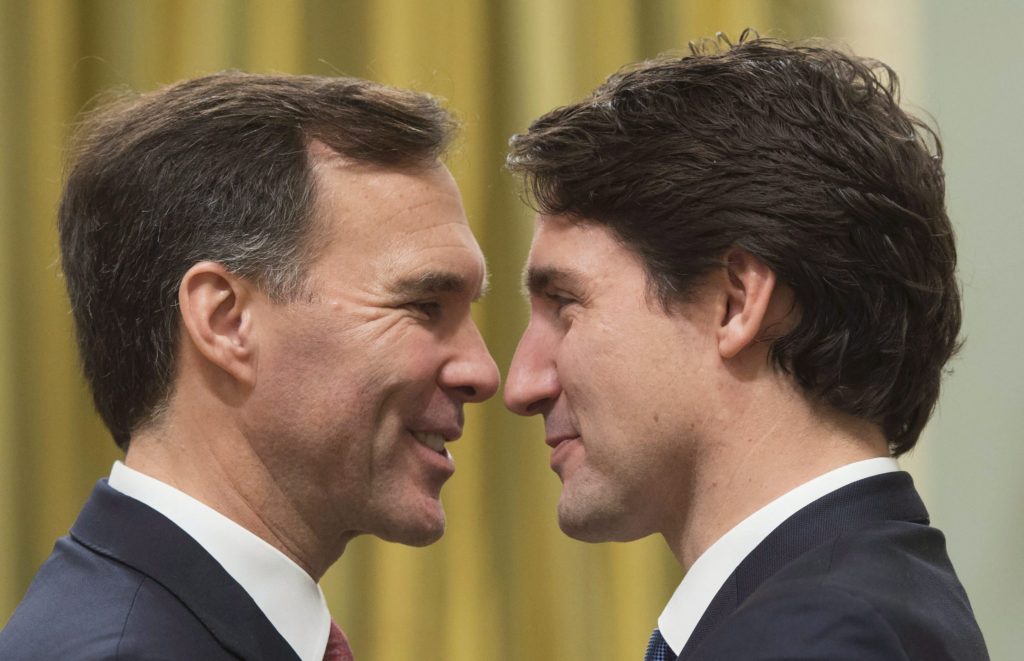 Prime Minister Justin Trudeau, right, goes face-to-face with Finance Minister Bill Morneau Photo credit – THE CANADIAN PRESS/Sean Kilpatrick “So, if you are looking for income stability or longevity, starting an SME may not be your best choice, and especially after the Trudeau/Morneau juggernaut has gutted some of the few benefits of being a small business owner. Some of the so-called loopholes the Trudeau/Morneau team wish to eradicate are in fact are a legitimate vehicle by which small business try to squirrel money for their retirement years.
“If the government is serious about fair tax reform they should at least do the following:”
Lengthen the consultative window to at least 6 months
Start listening to the many non-partisan tax experts who understand the tax laws and small businesses and are ready willing and able to contribute in a meaningful fashion.
 Joe Gaetan spent 13 of his fifty years of uninterrupted employment as a small business owner. He operated a Laser Smoking Cessation business, treating over 5,000 during the the life of the business. He retired from that business in 2013. Prior to that he worked for a Fortune 100 company. Joe Gaetan spent 13 of his fifty years of uninterrupted employment as a small business owner. He operated a Laser Smoking Cessation business, treating over 5,000 during the the life of the business. He retired from that business in 2013. Prior to that he worked for a Fortune 100 company.

|
|
 By Pepper Parr
By Pepper Parr The Draft of the Official Plan will be public on Friday – it runs close to 1000 pages. Those with a major interest in the contents of that document are going to have less than 20 days to respond to it.
The Draft of the Official Plan will be public on Friday – it runs close to 1000 pages. Those with a major interest in the contents of that document are going to have less than 20 days to respond to it. There are the plans for the redevelopment of the Waterfront Hotel property that the city is pushing with their Emerging Preferred Concept. There are citizens who don’t like what they are seeing.
There are the plans for the redevelopment of the Waterfront Hotel property that the city is pushing with their Emerging Preferred Concept. There are citizens who don’t like what they are seeing.
























 Instead, the HDSB predetermined ahead of time what the problem was – low utilization and surplus seats – but would never acknowledge that this was caused by them in their deliberate plans and concealing of the facts. In fact, the PARC members were presented with the problem of which school(s) to close as their starting point, not as one of their potential outcomes.
Instead, the HDSB predetermined ahead of time what the problem was – low utilization and surplus seats – but would never acknowledge that this was caused by them in their deliberate plans and concealing of the facts. In fact, the PARC members were presented with the problem of which school(s) to close as their starting point, not as one of their potential outcomes.
 So, Robert Bateman high school was chosen as well, and it appears that having had Central high school as the focus early on in the PAR process, was simply in an effort to create a distraction from the real agenda. What were the UTZ numbers, and arguments, that changed the initial closure of Central to Bateman?
So, Robert Bateman high school was chosen as well, and it appears that having had Central high school as the focus early on in the PAR process, was simply in an effort to create a distraction from the real agenda. What were the UTZ numbers, and arguments, that changed the initial closure of Central to Bateman? In addition, there is no explanation – it was a subjective HDSB decision. As you know, with the changes made in boundaries, feeders and programs, Lester B. Pearson was chosen to close, with premeditation…..as was Robert Bateman.
In addition, there is no explanation – it was a subjective HDSB decision. As you know, with the changes made in boundaries, feeders and programs, Lester B. Pearson was chosen to close, with premeditation…..as was Robert Bateman.
 Tony Brecknock is a Burlington resident who is passionate about the school in his neighborhood that his School Board has decided to close. Mr Brecknock believes the Board is being less than candid with the people it is in place to serve and has set out his opinion on the Administrative Review that is now taking place.
Tony Brecknock is a Burlington resident who is passionate about the school in his neighborhood that his School Board has decided to close. Mr Brecknock believes the Board is being less than candid with the people it is in place to serve and has set out his opinion on the Administrative Review that is now taking place.


 Ray Rivers writes weekly on both federal and provincial politics, applying his more than 25 years as a federal bureaucrat to his thinking. Rivers was a candidate for provincial office in Burlington in 1995. He was the founder of the Burlington citizen committee on sustainability at a time when climate warming was a hotly debated subject. Tweet @rayzrivers
Ray Rivers writes weekly on both federal and provincial politics, applying his more than 25 years as a federal bureaucrat to his thinking. Rivers was a candidate for provincial office in Burlington in 1995. He was the founder of the Burlington citizen committee on sustainability at a time when climate warming was a hotly debated subject. Tweet @rayzrivers




 Certainly, it looks like no matter how overfilled Hayden was projected to become, and in fact did so, with portables, busing and 151% UTZ, the boundaries chosen, and feeders, that generated this result remained unchanged. This outcome, despite several other schools becoming under-filled and under-utilized, seems to reveal again the Board premeditated plan to close schools – the boundaries chosen by the board were kept stable, regardless of the cost of 2 schools.
Certainly, it looks like no matter how overfilled Hayden was projected to become, and in fact did so, with portables, busing and 151% UTZ, the boundaries chosen, and feeders, that generated this result remained unchanged. This outcome, despite several other schools becoming under-filled and under-utilized, seems to reveal again the Board premeditated plan to close schools – the boundaries chosen by the board were kept stable, regardless of the cost of 2 schools. So they delivered on this criterion, even in the PAR. Again, how does this fit what the parents I think would consider a trustworthy and rational decision to contribute to the benefit and well-being of the students, and the community of schools?
So they delivered on this criterion, even in the PAR. Again, how does this fit what the parents I think would consider a trustworthy and rational decision to contribute to the benefit and well-being of the students, and the community of schools?










 And what was really missing from her announcement is an indication as to how the government plans to deal with the evolution taking place with the daily news. The dailies are a dying breed as advertising revenue, circulation and employment are all in a downward spiral. And once the papers go, so too will the press associations which they support, the ones which provide front-line reporting of events upon which we should all depend.
And what was really missing from her announcement is an indication as to how the government plans to deal with the evolution taking place with the daily news. The dailies are a dying breed as advertising revenue, circulation and employment are all in a downward spiral. And once the papers go, so too will the press associations which they support, the ones which provide front-line reporting of events upon which we should all depend.




 Cheryl is a Registered Nurse who was a member of the Program Accommodation Review Committee that was unable to reach a consensus on which if any Burlington high schools should have been closed.
Cheryl is a Registered Nurse who was a member of the Program Accommodation Review Committee that was unable to reach a consensus on which if any Burlington high schools should have been closed.




 George Ward is a semi- retired quality control auditor who is deeply involved in the community effort to keep the Lester B. Pearson high school open. Both his children and some of their children attended Lester B. Pearson.
George Ward is a semi- retired quality control auditor who is deeply involved in the community effort to keep the Lester B. Pearson high school open. Both his children and some of their children attended Lester B. Pearson.



 Ray Rivers writes weekly on both federal and provincial politics, applying his more than 25 years as a federal bureaucrat to his thinking. Rivers was a candidate for provincial office in Burlington in 1995. He was the founder of the Burlington citizen committee on sustainability at a time when climate warming was a hotly debated subject. Tweet @rayzrivers
Ray Rivers writes weekly on both federal and provincial politics, applying his more than 25 years as a federal bureaucrat to his thinking. Rivers was a candidate for provincial office in Burlington in 1995. He was the founder of the Burlington citizen committee on sustainability at a time when climate warming was a hotly debated subject. Tweet @rayzrivers


 Ray Rivers writes weekly on both federal and provincial politics, applying his more than 25 years as a federal bureaucrat to his thinking. Rivers was a candidate for provincial office in Burlington in 1995. He was the founder of the Burlington citizen committee on sustainability at a time when climate warming was a hotly debated subject. Tweet @rayzrivers
Ray Rivers writes weekly on both federal and provincial politics, applying his more than 25 years as a federal bureaucrat to his thinking. Rivers was a candidate for provincial office in Burlington in 1995. He was the founder of the Burlington citizen committee on sustainability at a time when climate warming was a hotly debated subject. Tweet @rayzrivers








 Ray Rivers writes weekly on both federal and provincial politics, applying his more than 25 years as a federal bureaucrat to his thinking. Rivers was a candidate for provincial office in Burlington in 1995. He was the founder of the Burlington citizen committee on sustainability at a time when climate warming was a hotly debated subject. Tweet @rayzrivers
Ray Rivers writes weekly on both federal and provincial politics, applying his more than 25 years as a federal bureaucrat to his thinking. Rivers was a candidate for provincial office in Burlington in 1995. He was the founder of the Burlington citizen committee on sustainability at a time when climate warming was a hotly debated subject. Tweet @rayzrivers





 The truth is that our tax system is a mess, a morass of loopholes and tax exemptions which have crept up on us like cobwebs in an untidy garage. Successive governments kept gluing on these addenda, primarily doing their best to serve the needs of the country, and too often and sadly, serving the needs or their electoral base in spite of the country.
The truth is that our tax system is a mess, a morass of loopholes and tax exemptions which have crept up on us like cobwebs in an untidy garage. Successive governments kept gluing on these addenda, primarily doing their best to serve the needs of the country, and too often and sadly, serving the needs or their electoral base in spite of the country. Aside from the loopholes and the degree of progressivity, there is the whole tax filing process. Once upon a time we could get by by mailing in a measly four sheets of paper and a couple T-4s. Today’s return requires reams of annexes and tables up the wazoo. There are now literally dozens of private sector computer-based and on-line packages and they are all just different enough to make them proprietary, though they all claim to be accurate.
Aside from the loopholes and the degree of progressivity, there is the whole tax filing process. Once upon a time we could get by by mailing in a measly four sheets of paper and a couple T-4s. Today’s return requires reams of annexes and tables up the wazoo. There are now literally dozens of private sector computer-based and on-line packages and they are all just different enough to make them proprietary, though they all claim to be accurate. Might one speculate that the Liberals are hoping the changes they are making, like decorating a house room at a time, will be harder for any subsequent Conservative government to dismantle and discard? Or perhaps the task of tearing down and reconstructing the entire building at one time is just too daunting for a government nearing the middle point in its term in office. In which case we can only hope that there is a master blueprint for the design of a better castle or implement shed.
Might one speculate that the Liberals are hoping the changes they are making, like decorating a house room at a time, will be harder for any subsequent Conservative government to dismantle and discard? Or perhaps the task of tearing down and reconstructing the entire building at one time is just too daunting for a government nearing the middle point in its term in office. In which case we can only hope that there is a master blueprint for the design of a better castle or implement shed.



 Joe Gaetan spent 13 of his fifty years of uninterrupted employment as a small business owner. He operated a Laser Smoking Cessation business, treating over 5,000 during the the life of the business. He retired from that business in 2013. Prior to that he worked for a Fortune 100 company.
Joe Gaetan spent 13 of his fifty years of uninterrupted employment as a small business owner. He operated a Laser Smoking Cessation business, treating over 5,000 during the the life of the business. He retired from that business in 2013. Prior to that he worked for a Fortune 100 company. 




